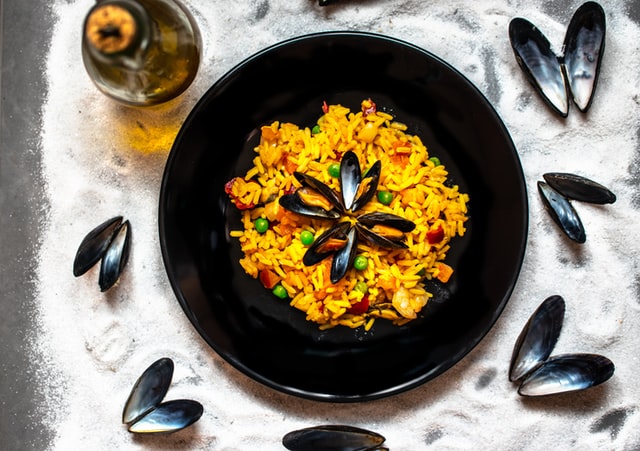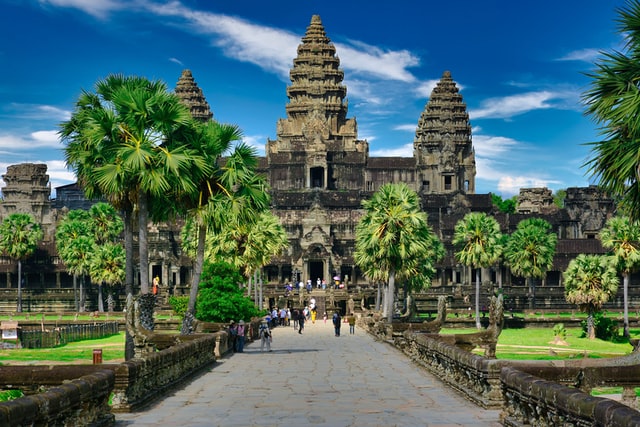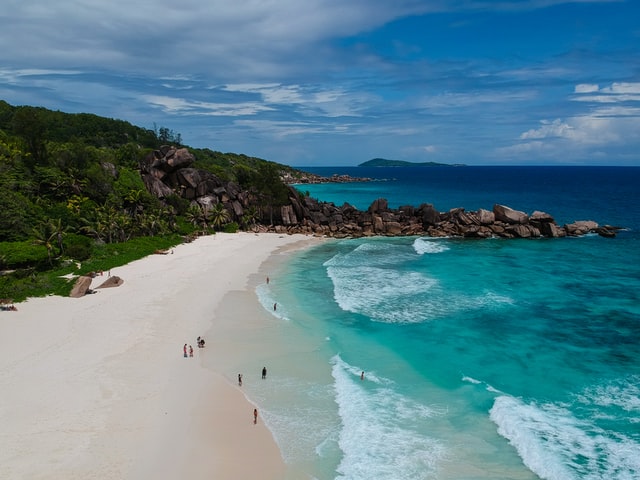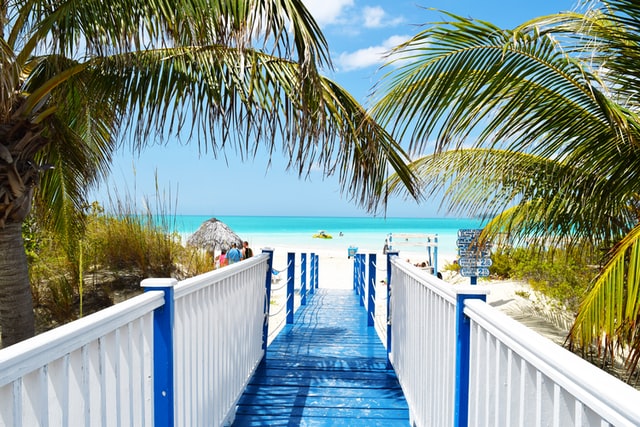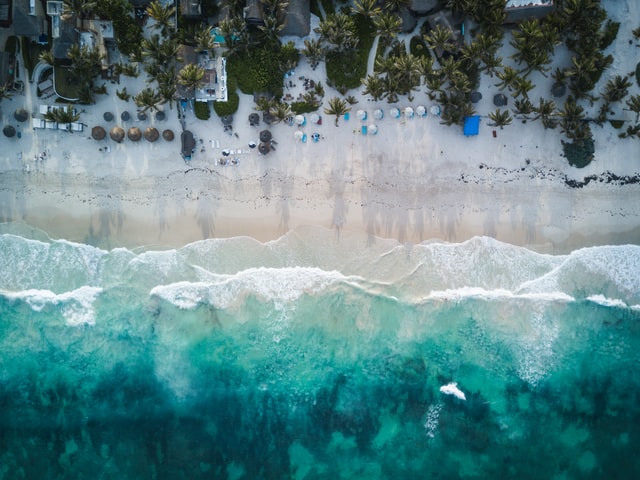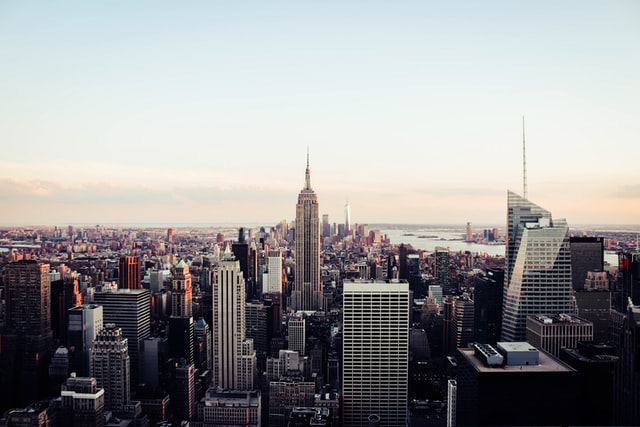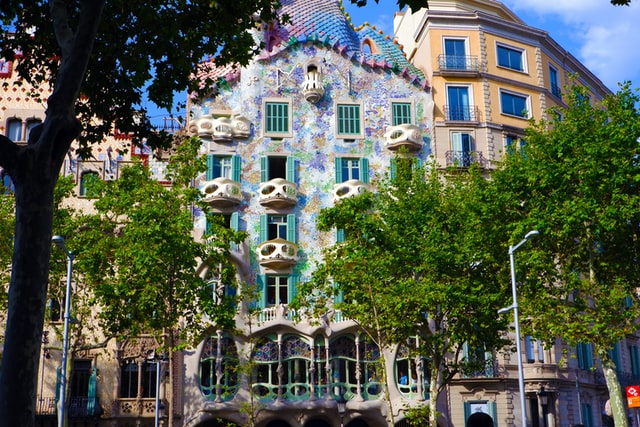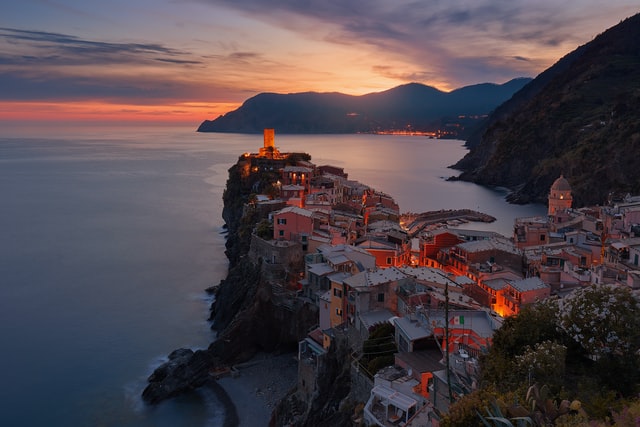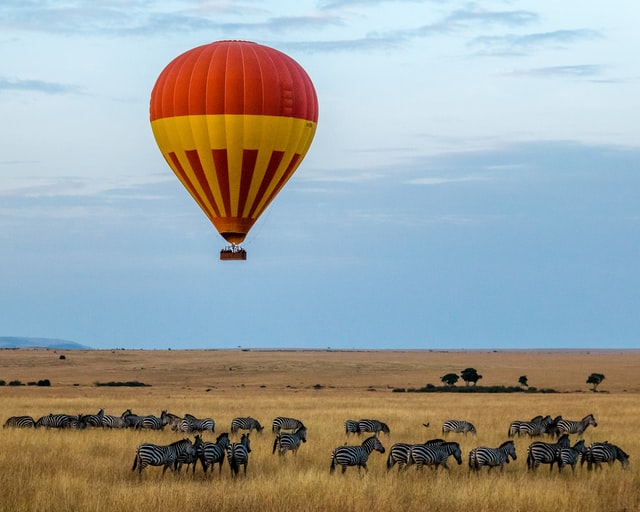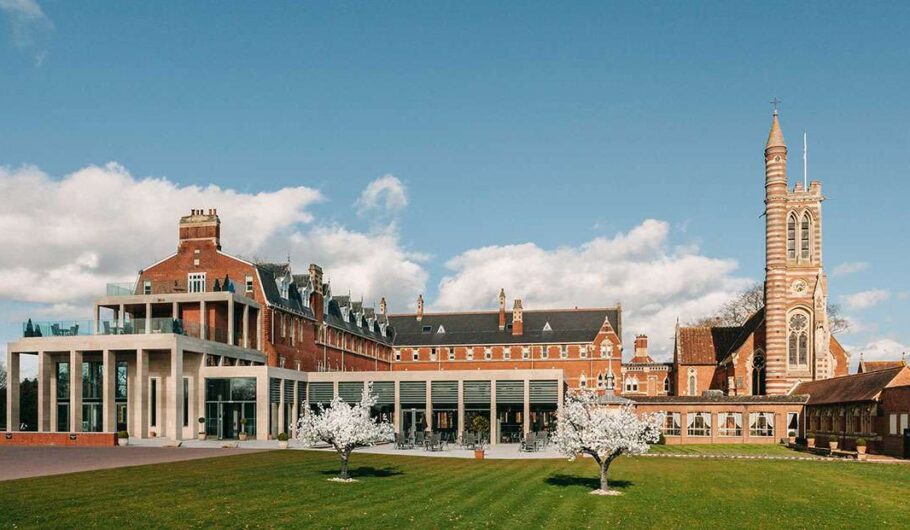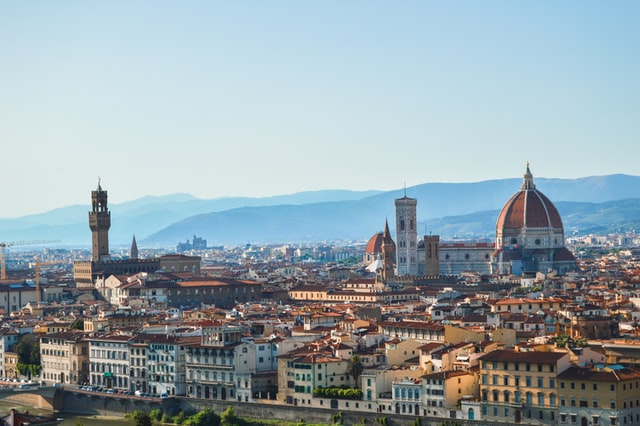The best luxury food and wine tours in Spain

Spain—the country’s name conjures up visions and dreams of clear skies, warm weather, and mouthwatering culinary delights. A land full of rich history and bold architecture, this Mediterranean paradise draws in tourists and connoisseurs every year, who wish to soak up the Spanish sun while satisfying their cravings for tantalizing delicacies and world-class wines. Whether you have a penchant for seafood, tapas, fine wines, or all of the above, here are some of the best food and wine tours to indulge in on your next luxury getaway in Spain.
Fat Tire Tour’s Night Tapas Tour

Imagine spending an evening sampling some of Spain’s most delectable tapas and wines, and then finishing off the experience with a spectacular flamenco show. Fat Tire Tours, a Paris-based touring company that operates in over 12 cities in the U.S. and Europe, offers a wide variety of food-focused tours, including the Night Tapas Tour and Flamenco Show in Barcelona.



This one-of-a-kind adventure allows you to sample the local fare while immersing yourself in the history of Catalan food culture. On this trip, you will spend the evening walking Barcelona’s Born neighborhood, topped off with a traditional flamenco performance in a seventeenth-century palace. This tour is an exceptional (and delicious) experience for food addicts and art lovers alike.
Jerez and Cadiz Wine Tasting and Horse Show

If you are an avid equestrian or horse lover who also enjoys sampling fine wines, then you should consider taking Veltra City Discovery’s Jerez and Cadiz Wine Tasting and Horse Show. On this tour, you will depart from Seville and embark on a trip to a winery in Jerez, where you can sample Spanish sherry and learn about the Spanish wine-making process.


After you’ve had your fill of spirits, you will head off to the Royal Andalucian School of Equestrian Art to watch a horse ballet, full of impressive tricks and choreography. Finally, your tour guide will take you to Europe’s oldest city, Cadiz, so that you can wander through the spectacular city center and marvel at the city’s glorious seventeenth-century architecture.
The Valencia Paella Project

Are you a fan of Paella? Amateur chefs and foodies from around the world sign up for the Valencia Paella Project each year. This three-day culinary experience includes walking tours, a paella cooking class, and a series of wine-tastings. Spend three days in Valencia learning how to make rich, savory, and authentic paella from master chefs, who will even take you to local markets to find top-notch ingredients for the perfect dish.


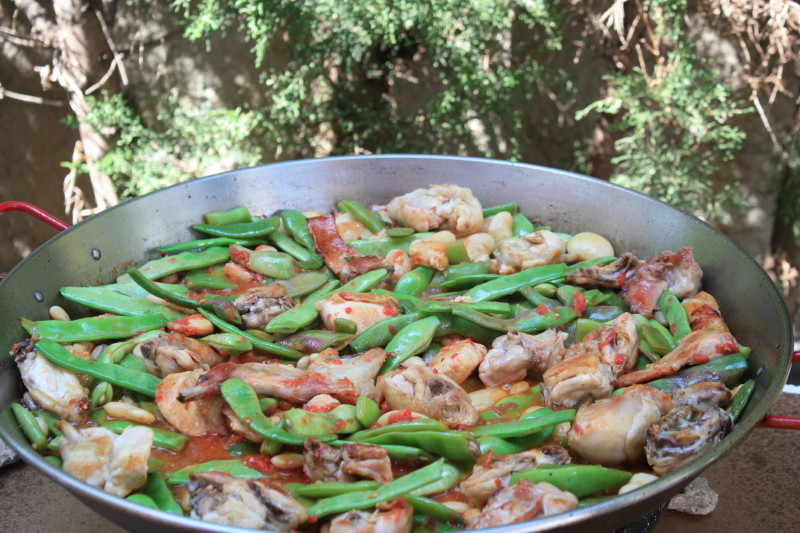
On this excursion, you will also have free time to dine at other local restaurants and immerse yourself in Valencia’s historic scenery. A romantic and adventurous experience, this journey will leave both your heart and your stomach full.
La Mancha and Don Quixote Mills Tour

If you enjoy curling up with a good book and a glass of wine, then this Don Quixote-themed tour through the legendary La Mancha region of Spain is sure to delight and captivate your imagination. Explore the land of windmills where Miguel de Cervantes’ iconic character Don Quixote gallivants with his hapless companion Sancho Panza, and stop at the UNESCO world heritage site Aranjuez, a breath-taking municipality with a royal palace built in the sixteenth century. This trip will also transport you through some of Spain’s most productive wine country, where you can try some of the country’s most exquisite spirits and learn about the history of the region.
Basque Cooking with Gourmet on Tour

San Sebastian, a region in Northern Spain, is home to a variety of Michelin Star restaurants and a rich food culture that is world-renowned. This tour will expose you to all the region has to offer, from the vineyards of Rioja to the Guggenheim museum to the northern fishing villages, where Spain’s fishermen harvest the best seafood. Along this journey, you will participate in a cooking class to learn about Basque cuisine, as well as embark on a tapas and pintxo bar tour to sample the local fare. Accommodation options include a five-star hotel or a nineteenth-century villa for a culture-filled adventure that is equally relaxing and restful.


By Anne-Marie Pritchett
Open hotels in Cambodia for a staycation


As 2020 draws to an end and we continue to explore Cambodia from our Siem Reap home, we travel a little further afield this month to feature 3 hotels and resorts that are currently open in Cambodia for a staycation. Each of them are unique in their own way, as are their locations, but they all present an excellent staycation option just a few hours from either Siem Reap or Phnom Penh. They have all worked hard to open for guests, despite the current (ever changing) restrictions and lack of tourists in Cambodia, and are striving to provide expats and locals alike the chance to escape for a few days and enjoy what they each have to offer.
Our first suggestion is the historic restored mansion, Le Relais de Chhlong in Kratie.
Chhlong, is a sleepy riverside town in Kratie province. Situated on the banks of the mighty Mekong river (which is the longest river in Southeast Asia) it makes for the perfect weekend escape from either Phnom Penh or Siem Reap. Many people choose to visit Kratie for the chance to catch a glimpse of the Irawaddy dolphins, an endangered species that is found in the Mekong. Cycling in the area is popular too, with a series of paths on both sides of the river that allow even novice ‘weekend’ cyclists the chance to enjoy the countryside due to the forgiving terrain. Le Relais de Chhlong is a delightfully restored family mansion that is now living a new life as a boutique hotel. With just 8 spacious suites to choose from, each with balconies and roll top baths this is a wonderful place to relax and soak up some of that yesteryear charm. Mountain bikes are available for guests to borrow and even a gentle cycle to explore the market and old town with the yet to be renovated colonial buildings will provide a unique experience. Nearby, you can also visit the unique ‘House of 100 Pillars’ which has recently been purchased by the Ministry of Culture and Fine Arts meaning it will be moved to a new location and fully restored. After exploring local riverside life, meander your way back to Le Relais de Chhlong where you can relax by the pool with your favourite book before enjoying a glass of wine and a game or billiards before dinner. All the time, try to use your wildest imagination to think just what it must have been like to call this beautiful building home, more than 100 years ago.
Next up, is the simply stunning and unique Amber Kampot in Kampot Province.
With Kampot being less than 4 hours drive from the bustling capital of Phnom Penh, it has for a long time offered an excellent option for a weekend escape from the city. And where better to enjoy your time in Kampot that at the peerless Amber Kampot which is truly the perfect place to escape from it all. This brand new riverside resort offers guests a selection of beautifully appointed, one and two bedroom pool villas that make for an idyllic luxury staycation. Be welcomed by a staff team who will make your stay memorable, experience refined fine dining at Arvi whilst enjoying unrivalled Kampot river views before treating your body, mind, and soul to an invigorating spa treatment. Amber Kampot is perfectly located to explore the area, with Bokor Mountain National Park being just a few km away, and the seaside town of Kep also a short drive from town. Or you can choose to visit the nearby salt fields or one of the local Kampot pepper farms to gain an understanding of how these seasoning staples begin their lives. But in reality, despite having these options within easy reach, once you check in to Amber Kampot, one of the finest luxury resorts in Southern Cambodia, you will probably never want to leave…


Finally, we feature the former stately home to US ambassadors, White Mansion in Phnom Penh.
Phnom Penh is the bustling, sometimes chaotic capital city located at the confluence of the Mekong River and Tonlé Sap lake. Home to the Royal Palace, Silver Pagoda and the National Museum, there are also a vast array of restaurants, cafes and bars that cater to all tastes and shopping opportunites that include boutique designers, local markets and international malls. On leafy street 240 in the heart of Phnom Penh, just a few blocks from the iconic Independance Monument, is White Mansion. The choice of name becomes clear when you enter the gated courtyard and first view the grand pillared facade and enter the spacious yet welcoming lobby. If you look closely you will see the United States of America residence plaque next to the entrance gate and above the door as this grand building once housed American ambassadors and their guests prior to it’s reinvention as a boutique hotel. Rooms and suites are elegant, with many boasting a balcony or terrace, and the 20m lap pool offers guests the chance to revitalise themselves after an exhausting day exploring Phnom Penh.

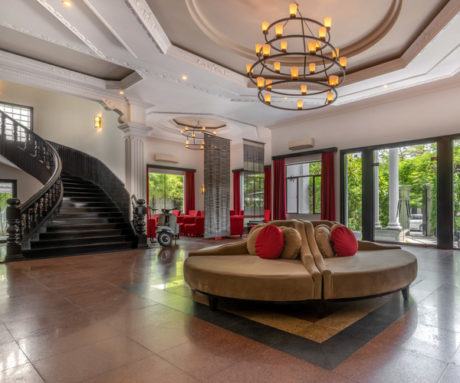
We hope you enjoyed our suggestions and whilst overseas travel remains impossible for many, now is the time to support local hotels and resorts wherever you live, and for us that means Cambodia. Making the effort to stay local and buy local during these challenging times will help them to survive, whilst at the same time providing us all with that wanderlust fix that we desire. In addition, when the borders open those hotels and resorts that have remained open in Cambodia will be waiting with open arms, their teams happy and excited to welcome overseas guests once again.
By Paul Eyers
Sailing in the Seychelles

Located to the north east of Madagascar and strewn with World Heritage Sites, the granite archipelago of the Seychelles clusters together approximately 115 inner and outer islands. While the more remote outer islands can be reached with a local guide or specifically trained captain on board, most visited are the inner islands, including well-known Praslin, La Digue and Mahé.
A popular yacht charter destination, most are less than 30 nautical miles apart, delivering short sailing times for easy island hopping. Yachting here offers ribbons of powder white beaches, fringed by palm trees and lapped by crystal clear waters with the opportunity to explore secluded lagoons, colourful reefs and coral atolls. Filled with culture, home to unique flora and fauna and countless points of interest, this tropical paradise is a spectacular location to embrace tranquillity and relaxation.
An ideal starting point for a yacht charter, Mahé is home to 90% of the Seychelles’ population and the site of the republic’s capital and only port, Victoria. Built in 1840 and renovated in 1999, Mahé’s bustling market will give you a feel for the authentic Seychellois way of life, with fantastic fresh produce and spices available. A short sail provides access to the stunning six islets of Sainte Anne Marine Park, one of the largest areas of sea grass where hawksbill and green turtles are often found, alongside bottlenose dolphins. Ideal for snorkelling amongst the coral reefs teeming with marine life, there are also glass bottom boat trips to enjoy.

It is said that there is treasure buried on privately owned Moyenne Island, where remains of early settlers’ homes and pirates’ graves are found amongst the tropical gardens as giant tortoises roam free. Follow the half hour walking trail around the isle for panoramic views and discover one of the most filmed and photographed beaches in the world, where pink granite rocks and white sands create a sublime vision of beauty. Neighbouring Round Island boasts a popular Creole restaurant, Long Island is a favourite for chilled relaxation, while uninhabited Ile Cachée boasts a nature reserve with a superb site for dive enthusiasts.

The fourth largest island in the Seychelles, La Digue takes its name from one of the 1768 exploration vessels in Marion Dufresne’s French fleet of discovery and is a nature-lovers haven. Bursting with biodiversity, La Digue hosts the Seychelles’ black paradise flycatcher, one of the rarest birds on earth, alongside many other species plus two rare breeds of terrapin. This wealth of nature is echoed in the flora of lush forests where delicate orchids, vanilla vines and Indian almond trees thrive, and stunning gardens are filled with hibiscus and nepenthes alongside swaying palms. Blessed with tranquillity, time stands still on this island and travelling by bicycle is king. Local guides can organise cycling, hiking and rock-climbing tours, or you may like to sign up for surfing lessons, as this is an idyllic spot to learn. Famous Anse Source d’Argent Beach is a must – classed as one of the top three beaches in the world, it is easy to see why with its stunning granite boulders, velvet sand and shallow, clear water, accessed via the beautiful Union Estate.

Numerous adjoining satellite islands are also wonderful to explore by yacht, offering private anchorages together with plenty of snorkelling and diving opportunities. To the north is Cocos Island, a marine park established in 1996, set around three small islets with shallow turquoise water. Fringed by large expanses of coral reefs, the waters here offer an exciting snorkelling experience. Nearby, the picturesque Sisters Islands, namely Grande Soeur and Petite Soeur, are popular for hiking and picnics thanks to their spectacular ocean panoramas, as well as offering prolific underwater marine life to discover. The delights of Félicité, Marianne and Anse Cocos are also worth exploring.

Take a short hop over to the reserve of Curieuse island, a small granite isle noted for the unique coco de mer palms, one of the Seychelles’ cultural icons and only found on two neighbouring islands. This is the habitat of the highly entertaining, wild, giant land tortoises, who will come to greet you and enjoy being hand fed. A rugged island once home to a leper colony, you can walk the trail from Baie Laraie to Anse José, passing through thick mangroves teeming with wildlife and past colonial architecture to discover the beach where sea turtles still arrive to lay their eggs. The Raffles Hotel is situated nearby offering an amazing opportunity to relax with a spa treatment or some cocktails! At the end of the day, sail over to St Pierre, a tiny islet that is a firm favourite with swimmers and yachtsmen, providing the ideal backdrop for the spectacular Seychelles sunset and close to Pointe Zanguilles on Praslin’s superb Cote d’Or Beach.

Make way to Anse Lazio, on the northwest of Praslin Island, possibly one of the best kept secrets in the Seychelles and the most famous beach on the isle. This is a great spot to soak up sensational views as azure waves lap the powder white shores and an ideal bay to enjoy all the water sports available on board, plus snorkel amongst the coral whilst looking out for turtles. Should you want to head ashore, Le Chevalier Restaurant is a popular stop for lunch, set amongst the shade of palm trees. There are lovely walking paths through the rich greenery of the peninsula, that lead to more secluded bays and vast bands of sandy beaches. The legendary Vallée de Mai UNESCO World Heritage Site on Praslin is so remarkable it was once believed to be the original site of the Garden of Eden. Hauntingly beautiful, the primeval forest is home to over 6,000 coco de mer trees, who in themselves are considered to be among the botanical wonders of the world. Home to six endemic palm species as well as other indigenous trees, this is also the last noted habitat of the endangered black parrot.
 From emerald jungles to secret anchorages, idyllic beaches to dramatic boulders, it is clear to see that the Seychelles deliver an enchanting getaway location that you will want to return to again and again. This extraordinary yachting haven, brimming with breath-taking views and exceptional nature is, quite simply put, the ultimate barefoot escape.
From emerald jungles to secret anchorages, idyllic beaches to dramatic boulders, it is clear to see that the Seychelles deliver an enchanting getaway location that you will want to return to again and again. This extraordinary yachting haven, brimming with breath-taking views and exceptional nature is, quite simply put, the ultimate barefoot escape.
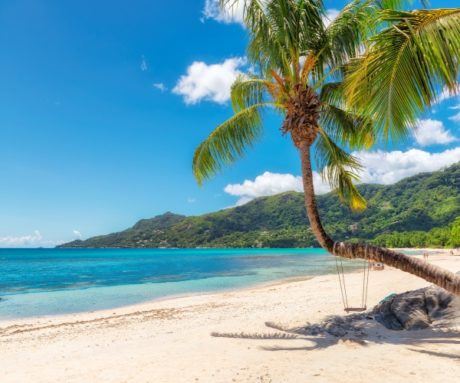
By Nicholas Dean
The best islands in the Caribbean to discover aboard a yacht
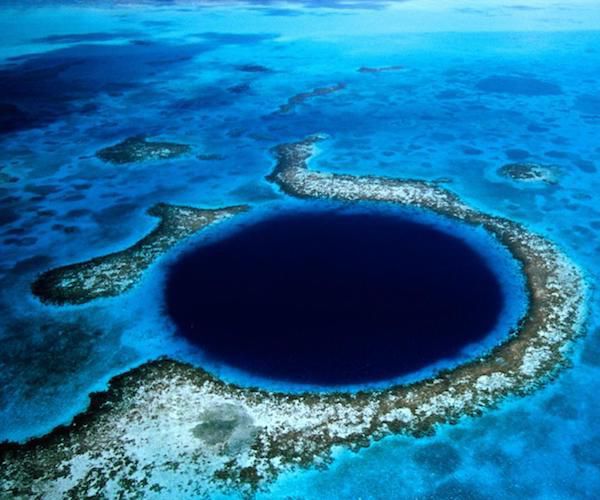
The Caribbean is one of the most popular charter destinations in the world. Its fantastic climate that allows you to travel throughout the year to enjoy its paradisiacal coves that offer privacy, comfort and a large cast of exclusive beach clubs are the main arguments for renting luxury yachts in the Caribbean islands.
If you are thinking of making an exotic vacation in the Caribbean aboard a yacht, we offer you the ten best destinations to enjoy with all kinds of luxury:
Belize
Belize is the ideal charter for explorers. It has more than 200 islands to explore with its luxury yacht and enjoy them from a privileged position. Ambergris Creek and Moho Creek are two of the most recommended among the hundreds of islands.
Likewise, lovers of fishing will find multiple locations that are ideal for fishing in total comfort from their boat, or through the auxiliary boat of their yacht.
Saint Martin
The island of Saint Martin offers different cultures. One half of the island is French while the other half is Dutch. With its capital in Phillipsburg, it is a tax free island so it is ideal for shopping after enjoying its beautiful coves such as Anse de Colombier.
Grande Case is known as the gastronomic capital of the Caribbean where you will find different exclusive restaurants where you can enjoy a nice dinner.
Bimini Islands
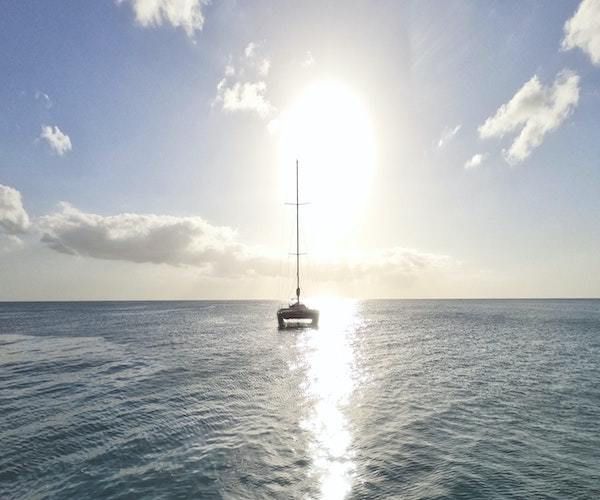
The Bimini Islands are ideal to satisfy all the needs of clients. Made up of three islands in the Bahamas, each one provides different services and attractions. Privacy is guaranteed to relax and sunbathe.
The crystal clear waters of Bimini Islands invite you to take a dip and explore the depths by snorkeling and diving. Like Es Vedrá on the island of Ibiza, it is believed that this location was the destination of the Atlantean civilization and provides a special energy.
One of the most recommended excursions is to “The Healing Hole”. This freshwater lake, which is only accessible by dinghy, has mineral properties such as sulfur or lithium for those who bathe in it.
British Virgin Islands
The British Virgin Islands are considered one of the yacht capitals of the world in the Caribbean. Its paradisiacal beaches offer numerous caves to explore with the tender boat. Inside are shallow waters ideal for snorkeling and discovering the Caribbean fauna.
Tranquility reigns in these waters thanks to the Francis Drake canal. In the cove of Jost Van Dyke White is the exclusive Soggy Dollar Bar where they serve their famous cocktail that mixes Pusser rum, coconut cream, orange juice and nutmeg.
Caty Cay Island
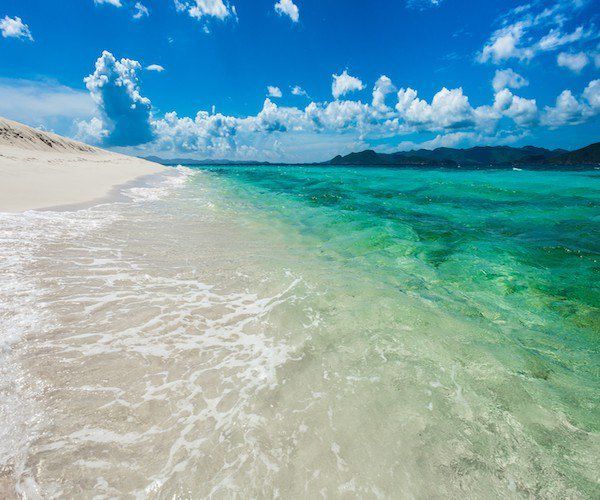
Caty Cay Island is considered the main entry point to the Bahamas. An island where privacy and intimacy reign from your luxury yacht to enjoy the views with a good meal prepared by your personal chef. Taking a bath provides total comfort, with shallow sandy coves.
Your privacy also allows you to enjoy a good cocktail or dinner in the exclusive nautical restaurant, located on the beach, while watching the spectacular Caribbean sunsets.
Leeward Islands
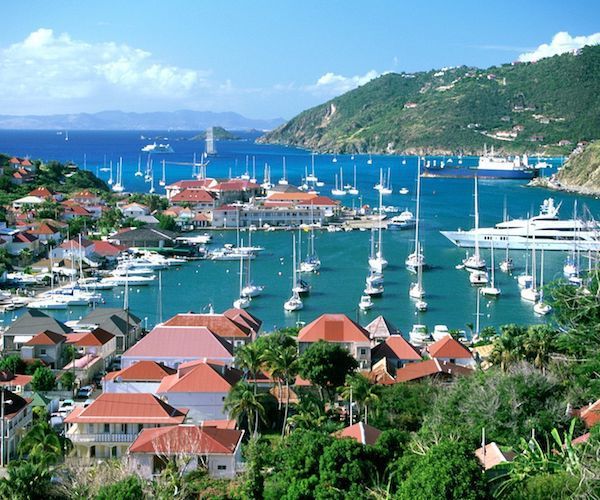
Located 90 miles east of the Bahamas, the Leeward Islands offer comfort and lots of history to all its visitors. European colonial islands in the 18th century, this set of islands is ideal for those who love to discover coves. One of the busiest routes is formed by the road that goes from Saint Martin to Saint Barth passing through Anguilla.
Anchor your yacht in Colombier, on the glamorous island of St. Barth, and enjoy a good swim and a relaxing day on your yacht sunbathing. Another major attraction of the Leeward Islands is the vibrant Creole Market in Marigol, the capital of the island of St. Martin.
Guadalupe Island
Guadalupe Island has an important French influence because it was an old Gallic colony several centuries ago. However, it is the perfect definition of a Caribbean island. Anchoring on the island of Gosier and Marie-Galante will allow you to enjoy complete privacy to sunbathe, relax and take a bath.
History lovers should anchor at Las Saintes to enjoy a good day on the high seas, before visiting the Fort of Napoleon in the afternoon. In Porstmouth and Dominica, on the other hand, you will find an extraordinary itinerary that will allow you to discover the Indian Riviera.
Saint Vincent and Grenadines
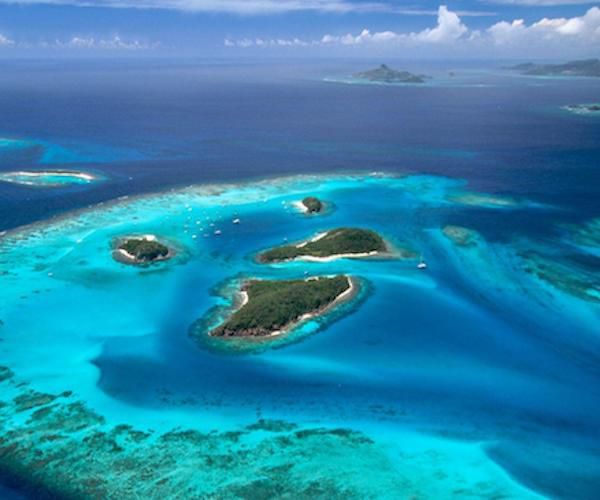
Saint Vincent and Grenadines offers numerous points to anchor your yacht and enjoy this volcanic and tropical paradise in the Caribbean. This set of islands combines excursions with numerous water activities.
Enjoy the seabed using the snorkeling and diving equipment at Tobago Cays Marine Park, where you can also practice water sports such as wakeboarding or paddle surfing. You can also disembark and discover Saint Vincent and Grenadines from above by visiting the La Soufriere volcano on the spectacular Bequia.
Puerto Rico
Puerto Rico, one of the Spanish Virgin Islands, has an ideal location for luxury yacht charter. Link between the United States and numerous Caribbean islands such as the British Virgin Islands, in this country you will find numerous islands and coves to discover.
Isla Palomino, Culebra and Vieques are ideal for practicing water sports, relaxing, sunbathing and admiring the wonderful sunset that the Caribbean is capable of hiding.
By Carmen Caballero
The best destinations to visit in Mexico

Planning an adventure can be a lot of fun and at the end of the day, the more research you put in then the higher the chances are you won’t miss any of the highlights. Best restaurants? Check. Unmissable UNESCO sites? Got it.
Today we are putting the spotlight on one of our favourite Latin American destinations – Mexico. Between the beautiful weather, sun-kissed beaches, ancient history and unique experiences, Mexico is a country that attracts almost every type of traveller. You could spend a week on the beach while partying the night away in Playa del Carmen, or you could lose yourself wandering the remnants of Maya ruins before dipping into a stunning cenote. We have put together some of the best places you must visit while in Mexico.
Mexico City

It goes without saying that the bustling capital of Mexico is a must see on your itinerary. Bursting with beautiful pre-Hispanic architecture and home to a variety of museums, markets, galleries and restaurants, it’s the perfect place to spend a few days getting acquainted with the Mexican culture. Highlights include the impressive Catedral Y Sagrario Metropolitano, the Plaza de la Constitution and the National Palace. Spend time walking around the Historic Centre and indulge in some pastries from one of the many bakeries in the area. If you are eager to experience some of Mexico’s high end restaurants, head to Condesa where you’ll find yourself in the heart of one of the city’s most fashionable areas. The tree-lined streets and boutique shops mirror what you might find in a trendy European neighbourhood.
Teotihuacan

The site of Teotihuacan is a short drive from Mexico City and makes for an excellent day trip out of the city. The ancient Mesoamerican site spans around 4km and walking around makes you appreciate its colossal scale that it would have possessed back in its day. It’s thought that it was built around 300 BC and now consists of pyramids, temples, palaces and a Ciudadela.The most notable buildings are the Temple of the Sun and the Temple of the Moon, two large pyramids that are amongst the most impressive outside of Egypt.
Puebla

This colourful colonial city is home to magnificent churches, a dramatic backdrop of volcanoes and peaks and a beautiful historic centre. One of Mexico’s oldest towns, Puebla means “City of the Angels” and was founded in 1531. Due to its rich history and impeccably preserved buildings, the historic centre is now a UNESCO World Heritage Site. Between the vibrant coloured architecture found round every corner and the ever-growing selection of restaurants and cafes, Puebla has grown in popularity over the years with people after a cultural holiday away from the crowds found in Mexico City.
Oaxaca

Continuing south on our Mexico itinerary we come to the city of Oaxaca – known for its incredible street food and fast becoming the gastronomic hub of Mexico. One of the highlights is the Templo de Santo Domingo, a 16th century church with a lovely Baroque style facade – perfect for photography lovers. We also recommend taking time to get lost down the cobbled streets where some of Oaxaca’s best independent galleries can be found, as well as quaint cafes and restaurants. Be sure to try some tlayudas, crispy tortillas topped with beans, cheese and avocado, as well as tamales, tacos and of course, tequila.
Just outside of the city you will also find the spectacular temples of Monte Alban, a pre-Columbian archaeological site that is the only pyramid in Mexico that sits at 400 metres. Explore tunnels, palaces, tombs and pyramids and admire the beautiful glyphs and carvings.
Merida

If you have the time to travel overland from Oaxaca to the Yucatan province, there are some wonderful places to be seen, including Palenque. However if you are shorter on time you can catch a flight from Oaxaca to Merida – capital of the Yucatan province. The “White City” is a lovely mix of churches and plazas, with the same beautiful buildings found elsewhere in Mexico. Walk amongst the brightly painted houses in the city’s downtown or lose yourself in the popular Museum of Modern Art, which regularly exhibits local artists showcasing Mexico’s rich culture and heritage. Visit the largest market, Lucas de Galvez, where you can try some dishes typical to the region as well as picking up beautiful handmade crafts. And if you can’t get enough of ancient ruins, visit Uxmal, a UNESCO-listed Maya ruin celebrated for its beautiful stone carvings.
Chichen Itza

Travelling southeast you can then stop at one of the most popular attractions in Mexico – Chichen Itza. The impressive Maya site was voted as one of the New 7 Wonders of the World and was built between the 7th and 10th century AD, serving as a centre of pilgrimage for the Maya for over 1000 years. The archeological site’s most famous attraction is the Temple of Kukulkan, which is dedicated to the feathered serpent God Kukulkan. Standing at about 30 metres high with a series of nine terraces, the pyramid was built with such precision that the shadow of a serpent descends down the steps during the equinox. As well as the main temple, you can explore the Great Ballcourt, the Temple of the Warriors and the Observatory, as well as other small temples and ruins. It’s worth spending a decent amount of time exploring the site and hiring a guide if you want to uncover the history behind the ruins.
Playa del Carmen, Isla Cozumel and Tulum

It’s time for the beach. We work our way east to the party city of Playa del Carmen. Not to everyone’s taste, Playa del Carmen has an incredible nightlife scene and some of the best beach bars in the region. A little quieter than the likes of Cancun, the resort town has white sand beaches and enticing bright blue water that’s perfect for swimming, snorkeling and other water based excursions. With chic beachside cafes and bars it’s another world from the ancient ruins you just left behind. If the scene in Playa del Carmen isn’t to your liking, then you could venture across the sea to the nearby island of Isla Cozumel. It’s considered one of the best scuba diving and snorkelling destinations in the region due to the crystal clear water and the abundance of marine animals. It has a more laid back atmosphere and it’s easier to find a quieter beach to relax on, perfect for those who like it a bit more peaceful. And if you haven’t quite had enough of the stunning Mexican beaches and gorgeous food, keep travelling south to Tulum. This beach town has risen dramatically in popularity over the years due to it’s hip food scene, instagram worthy locations and pristine beaches.
And finally, cenotes

While not a specific location, we can’t talk about the best places to visit in Mexico without highlighting cenotes. A “cenote” is a natural pool which has resulted from a collapse in the limestone rock that once surrounded it. They are scattered all through Mexico, with many being in close proximity to Merida, Tulum and Playa del Carmen. The often hidden swimming locations have fresh water that is filtered by the earth around it, and the water is often so clear that you can see small fish darting below. Visiting a cenote is the perfect way to unwind and relax for an afternoon while enjoying the natural surroundings.
By Matt Gannan
Buy now, stay later at Luxury Resorts around the world
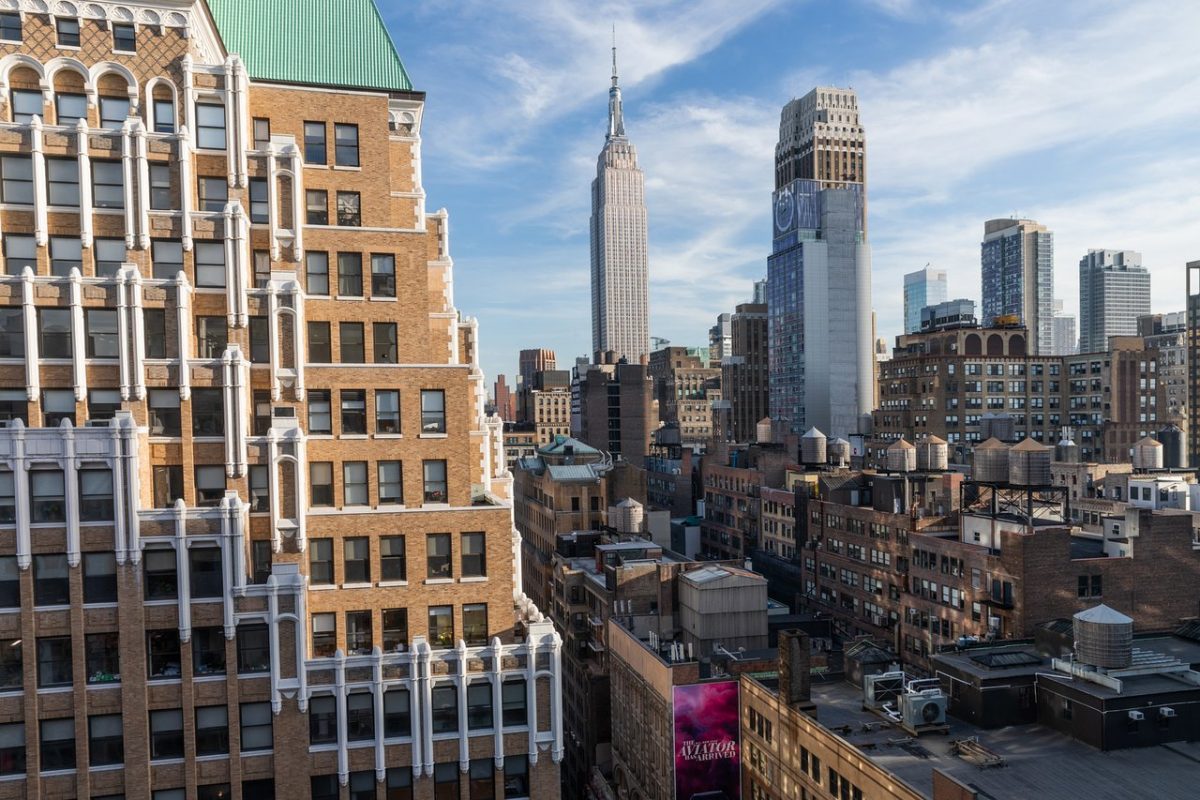
As the Covid-19 pandemic slows the pace of travel, the hospitality industry has experienced a drastic decline in revenue, prompting luxury hotels to brainstorm new ways to generate income. With the threat of massive furloughs and reduction of services on the horizon, iconic guesthouses have teamed up to offer an innovative solution to their customers: hotel bonds through the Buy Now, Stay Later program. Much like U.S. Treasury bonds, which started as a means of financing the Revolutionary War, hotel bonds allow regular guests to pay in advance for future stays.
Whatʼs the draw? Each $100 bond increases in value to $150 after a sixty-day maturation period—a smart, advantageous investment for avid travelers. Hotel bonds are a great way to invest in workers and the hospitality industry while financing longer post-pandemic travel dreams. Here are just a few of the high-end hotels from around the globe participating in this savvy venture, and more are signing up every day.
Radisson Hotel New York Times Square
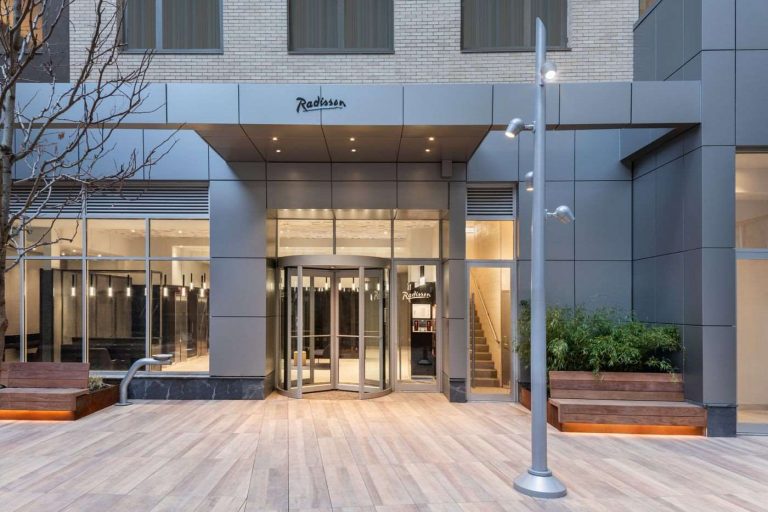
Love New York City? Radisson Hotelsʼ Times Square location offers convenient access to the best sites in Manhattan, from Broadway to Lincoln Center. Temporarily hampered by the Covid outbreak, this strategically located hotel is participating in the bonds program to keep its rooms reserved. The chainʼs modern facilities, stunning views of the Hudson Yards and Empire State building, and close proximity to Penn Station make it an ideal retreat for vacationers and business travelers alike. The hotel has everything a busy traveler needs, including room service, wi-fi, and mini-fridges, making it a smart investment for dream excursions to the Big Apple.
London House Chicago
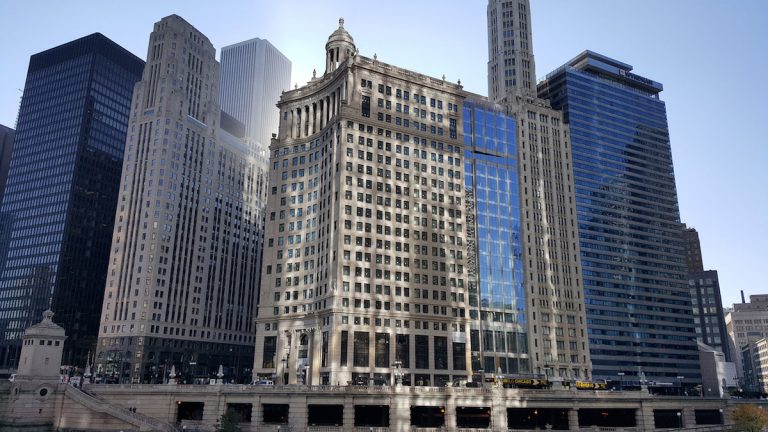
Located in the heart of the Windy City, London House Chicago is a top-of-the-line lifestyle hotel with sleek and cozy amenities. This guesthouse offers a range of high-end suites overlooking Downtown Chicagoʼs bustling streets, the perfect location for a business trip, weekend getaway, or company conference. Replete with a rooftop restaurant, spa, and fitness center, this snazzy hotel, which is housed inside a vintage renovated structure, combines relaxation and rejuvenation, high design and unrivaled comfort. Purchasing bonds in this hotel becomes a useful asset for anyone who plans on frequenting the Midwestʼs most iconic metropolis.
Hotel Providence Paris
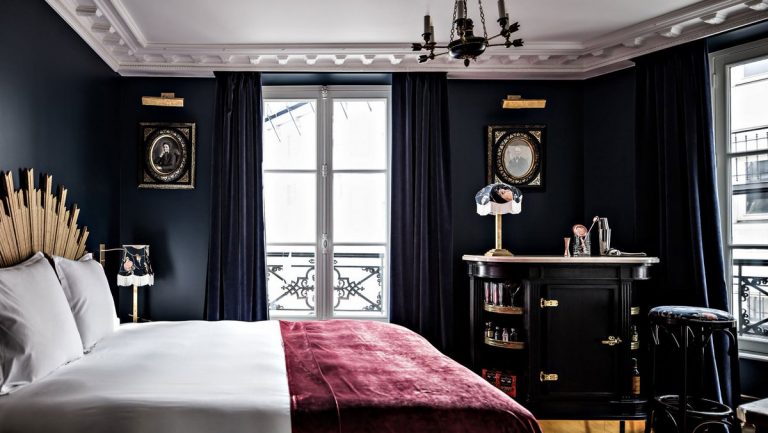
Did your summer vacation to Paris get put on hold because of coronavirus? No worries. Hotel Providence—a quaint Parisian estate with a distinctly vintage vibe—allows patrons to purchase bonds for a future visit to the famed City of Love. Many of the hotelʼs 18 wallpapered rooms come furnished with a cocktail bar, clawfoot bathtubs, and vinyl record players, immersing guests in a classic Parisian experience. Some rooms have a balcony with gorgeous views of local architecture, and the cozy atmosphere and distinctive character of each space makes this hotel a one-of-a-kind treasure worth revisiting.
The Pavilions Bali, Indonesia
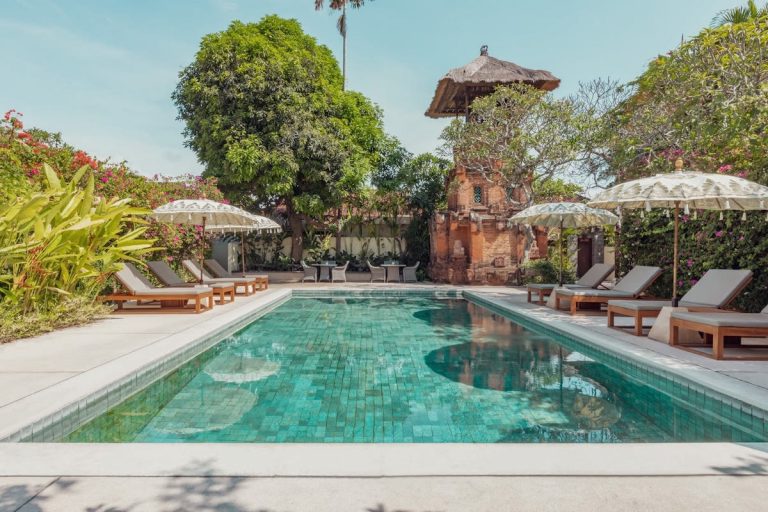
Known as an unparalleled tropical retreat, Bali, Indonesia, has become a favorite destination for honeymooners or vacationers looking for a luxurious private getaway. The Pavilions in Bali offers a host of welcoming and relaxing villas with an airy, open feel. Soak up the sun with your partner in this tranquil slice of paradise, which offers ocean views, world-class cuisine, yoga classes, and even secluded outdoor showers. Investing in a future stay at the Pavilions will give travelers something to look forward to when the pandemic finally passes and life returns to its new normal. With their crystal clear swimming pools and breezy, calming atmosphere, The Pavilions in Bali are among the best places to book and melt the stress away.
By Olivia Scott
Italy’s most beautiful villages

From Rome to Florence to Venice, Italy’s famous cities have little trouble drawing the eye, boasting an abundance of architectural splendour, ancient history and lauded landmarks. Yet there is beauty to be found off the beaten track – just as disarming, and just as alluring – encapsulated by the less-visited villages that sprinkle the hills of this Mediterranean peninsula.
Known as borghi, these small Italian towns and villages hold their own special charm. They’re pretty as a picture, with tucked-away trattorie, medieval towers and winding cobblestone streets, all set in bucolic surrounds a world away from the stresses of city living. The seven delightful borghi below are each members of I Borghi più belli d’Italia (‘The Most Beautiful Villages in Italy’) association, and all worthy of a detour from the tourist track.
Castiglione del Lago
Region: Umbria
This town’s position on the edge of Lake Trasimeno gives it an utterly romantic setting. Arguably the best view over the water can be enjoyed from Rocca del Leone (‘Fortress of the Lion’), a 13th-century fortress commissioned by Frederick II and built on the tip of the promontory. The rest of Castiglione del Lago is clustered behind the castle, stretching out into the pretty, green Umbrian countryside. Head here in April or May if you wish to attend the Coloriamo i Cielli festival, when the sky overhead becomes a dazzling display of hot-air balloons and multi-coloured kites.
Gradara
Region: Le Marche

The first brick of Gradara’s well-preserved castle was laid in the 12th century, and the last in the 15th. This imposing hilltop fortress is thought to have been the setting for Paolo and Francesca’s doomed affair in Dante’s “Inferno”. The rest of the town’s buildings are huddled around the castle, with the historical centre enjoying additional protection from another crenellated wall. All these defences were once vital for the resident nobility; now, they serve to attract admirers, who are welcome to venture beyond the Clock Gate for a closer look.
Today, Gradara’s ancient cobbled streets are at their liveliest in summer, when they play host to food festivals, street performances, music and arts events, and – most notably – a re-enactment of a famous 15th-century siege of the castle. This charming town sits amidst the rolling hills of rural Marche, flanked by picturesque vineyards and olive groves to its west, and the distant, sparkling waters of the Adriatic Sea to its east.
Deruta
Region: Umbria

Deruta lies to the south of Umbria’s capital, Perugia, and is brimming with historical buildings, from its gothic church to its medieval town hall. However, it’s for its traditional crafts that the town is most famous – specifically ceramics. This borgho is known for handmade majolica pottery, produced using clay deposits from the nearby River Tiber. During the 16th century, at a time of relative regional calm, Deruta’s artisans forged a reputation for creating beautiful, intricately decorated pottery that precedes them to this day. You can trace this interesting legacy at the Museum of Ceramics, and pick up your own gorgeous, handcrafted piece by which to remember your visit.
Montagnana
Region: Veneto

The medieval walls surrounding Montagnana – among Europe’s best preserved – climb up to 10 metres, extend for two kilometres and are studded periodically with crenellated watchtowers. That such robust fortifications were necessary comes as no surprise; this town’s exposed position in the open Veneto countryside meant it was vulnerable to attack from all sides. Visit today, however, and you’ll be greeted with a warm welcome, rather than a volley of arrows. Once within the walls, be sure to visit the gothic cathedral, stunning renaissance palaces, as well as the central castle.
Mondavio
Region: Le Marche

Scenically situated between the mountains and the coast, Mondavio is most famous for Rocca Roveresca, a 15th-century castle that owes its excellent condition to having never faced a siege. The fortress, complete with tunnels, drawbridge and moat, is now a museum, and installations depicting daily life inside its walls as well as various machines of war give visitors an insight into Modavio’s history. Notable buildings nearby include the town’s 18th-century art nouveau theatre, as well as old churches that house treasured works of art.
As you amble around the narrow streets, be sure to stop into one of the trattorie serving tacconi – a local pasta dish once a staple of Mondavio’s peasantry and made using bean flour. Visit in July and August to enjoy a range of events, from renaissance-styled feasts to re-enactments of wild boar hunts. Come in January to partake in the annual Pig Festival, celebrated with tastings, markets and more.
Arguà Petrarca
Region: Veneto

Arguà Petrarca is scenically situated on the slopes of Monte Ventolone and Monte Castello, within the Euganean hills to the south of Padua. The town has roots stretching back to before the Roman Empire. Its relatively more recent claim to fame is as the home where renaissance scholar and poet Frencesco Petrarca chose to spend his final years. It was in honour of this 14th-century luminary that the village gained the ‘Petrarca’ portion of its name in 1868. While here, you may wish to visit Petrarca’s house and gravesite. The medieval streets that so attracted him here appear to have changed little since his time, retaining their atmosphere, history and sense of tranquillity.
Valvasone Arzene
Region: Friuli

Located in the region of Friuli-Venezia-Giulia in northeast Italy, Valvasone Arzene began life as a 13th-century feudal castle. It developed outwards and gained fortifications over the coming centuries as it changed hands between regional powers. It is an excellent example of medieval town planning, constructed with a view to protecting access to a nearby river crossing and trade route. Visitors can explore the restored castle, the former houses of nobility and centuries-old churches for a glimpse into Valvasone Arzene’s fascinating history.
By Kerry Golds
Great private lodges in the African wilderness
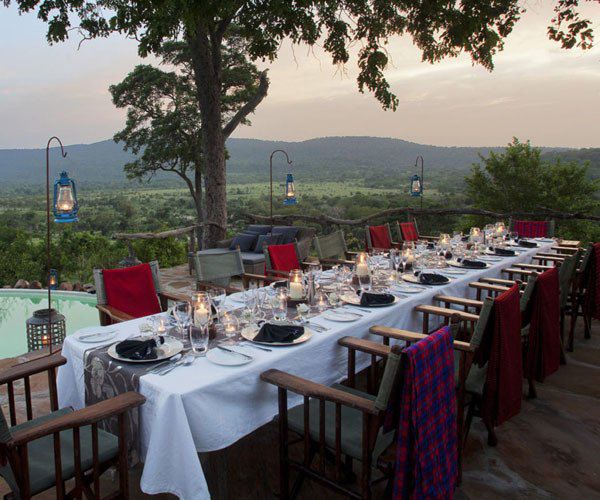
Africa’s safari camps and lodges are renowned for being especially intimate and wild, more so than any other hospitality experience throughout the rest of the world. Take the most private and most intimate lodges across the continent and you have the best wilderness experience the world has to offer. Dotted around safari Africa are several private lodges where you and the family can go to get away from it all in the ultimate exclusive retreat. Here is a rundown of the best places to do this.
Bailey’s Banda at Beho Beho. Selous Game Reserve, Tanzania
This is the ultimate old school safari experience. Dappled brick walls enclose guests in a haven of old era safari romance, with bushy views onto the raised hill which creepy up into the horizon. Watch the peaceful everchanging canvas of wilderness from your private plunge pool. This is the kind of scene that can change in a blink of an eye; a tranquil river scene can within a page of your book transform into a playground for elephants; a blank field can come alive with the howl of wild dogs in a split second. Staying at Beho Beho is as much about wildlife viewing from the luxury of your room as it is about the game drives…
Laragai House. Laikipia, Kenya
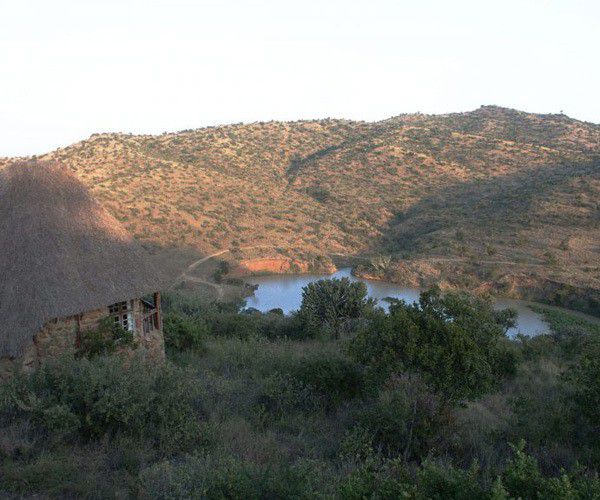
Laragai House is one of the original private venues for those who want exclusivity in a wild place. Laikipia is a haven for adventurers, and Laragai House is about as luxurious as it gets. It really does have something for everyone. Here, you feel isolated in the wild with sweeping and endless views of the undulating Borana hills below. You can be bathing by the pool admiring the view in the morning, and galloping around the below wilderness in the afternoon on your very own horse. Laragai House is the very best option on the continent for horse and wilderness lovers, all to be enjoyed from one of the finest private safari lodges on the continent.
The Motse. Tswalu, South Africa
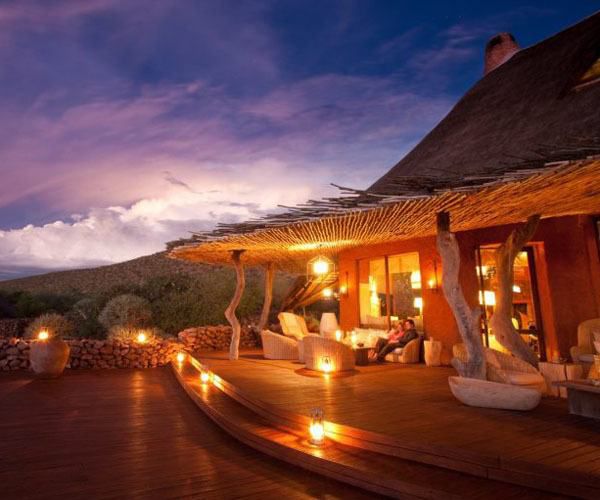
Twenty-four of your best friends and family can enjoy this fabulous private getaway. Perhaps The Motse is suited best for older families with teenagers, who want to tear around the surrounding wilderness in activities galore which is this action-packed private reserve. Guided activities include searching for pangolins, which are (incredibly) very easy to spot here; keeping wildlife enthusiast parents more than entertained. Perhaps, Tswalu is also excellent for younger families as it has no age restrictions and is, importantly, one of the only non-malarial reserves in southern Africa. For those who aren’t restricted by non-malarial zones, the nearby and easily accessible Cape Town is a perfect contrast and complement to an exceptional Tswalu safari.
Mkombe House at Nomad Lamai. Serengeti, Tanzania
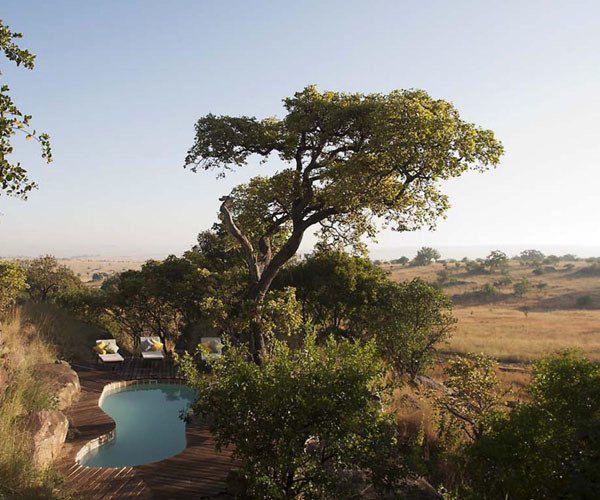
Mkombe House is the ultimate big 5 safari hideaway. The Serengeti National Park is brimming with lifetime it right heading to Lamai in July to October and your could be living in amongst one of the greatest, most spectacular natural events on the planet; the Great Wildebeest Migration. Indoors, Mkombe House cozies into a huge Kjope, huge towering mysterious boulders which are typical of this beautiful part of the park. Staying here is as close to nature as anyone could get. To avoid other tourists completely, I would recommend visiting in the off-season months when the Migration is not around. You will still be greeted by some of the best wildlife on the continent which never leave this action-packed park but for a lot less than in high season.
Chongwe House, Lower Zambezi. Zambia
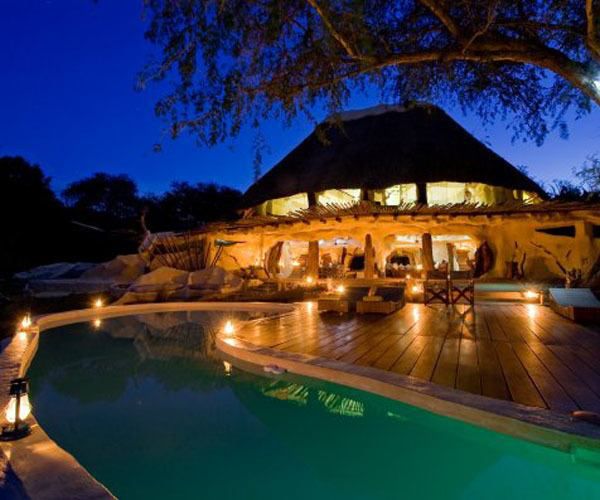
Chongwe House is what safari is all about; rustic, wild and with a hint of safari romance impossible to replicate on any other continent. Set on the banks of the Zambezi, enjoy a bright pink sunset and a cold drink after a long day of exploring this beautiful region. The wildlife in the park is superb, and the boating unparalleled in the country. For those who love fishing, Chongwe is the dream with some of the very best fishing opportunities on the continent. It is a hideaway for those who love a river view, and all the activities which come with it.
By Marc Harris
An active vacation in the Ecuadorian Andes
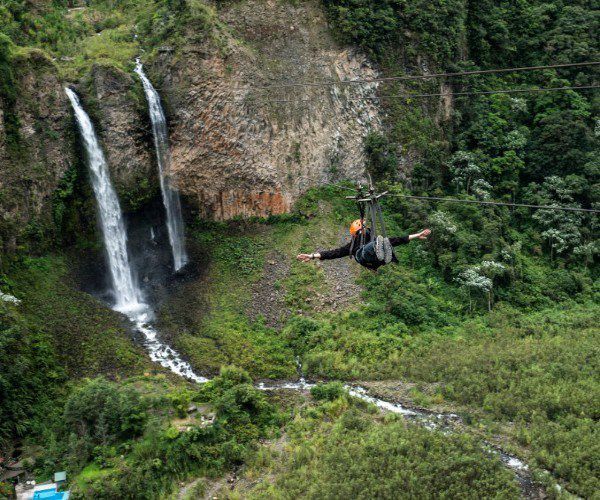
Ecuador is most known for the Galapagos Islands, but truth be told, Ecuador offers a wide variety of different activities in its mainland territory. From lush rain forest to snow-covered peaks in the Andes.
As almost all of us are quarantined at home and probably looking for something different and useful to read or to do, we have prepared a small itinerary that can help you plan your next vacation in 2021.
Go for an adventure in Baños
Just a few hours away from Quito, this small town located at the skirts of the Tungurahua volcano surrounded by waterfalls offers an unforgettable adventure for those who are looking to do something different and exciting during their stay in Ecuador.
Recommended activities while in Baños: Rent a bike and complete the waterfall route, trekking in the lush mountains nearby Baños, hike to the Devil’s Cauldron, swing over the edge of the world.
Complete the Quilotoa loop
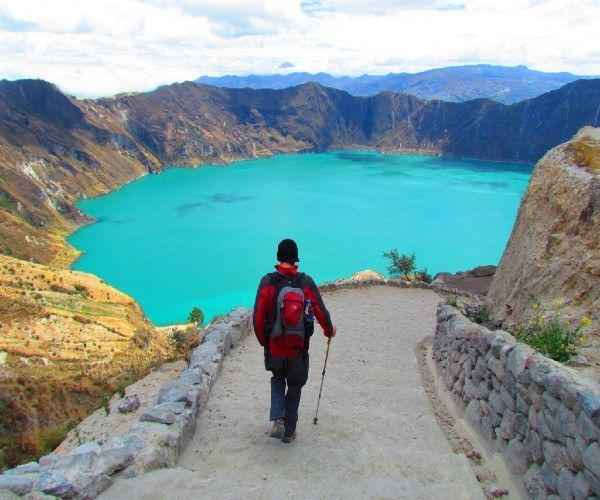
Quilotoa is an active volcano that erupted for the last time in the 13th century. After its last eruption, the peak of the volcano collapsed and created a wide caldera which later became a beautiful crater lake.
This place has many activities available for those who are looking to admire the beautiful Andean landscapes and spend some time outdoors.
If you are an active person, you can hike all the way around the crater rim or hike down into the crater. Rent a kayak and explore the lake on your own, and, if you are feeling more adventurous camping and stargazing on the side of the lake is definitely a must.
Horseback riding in the Cotopaxi
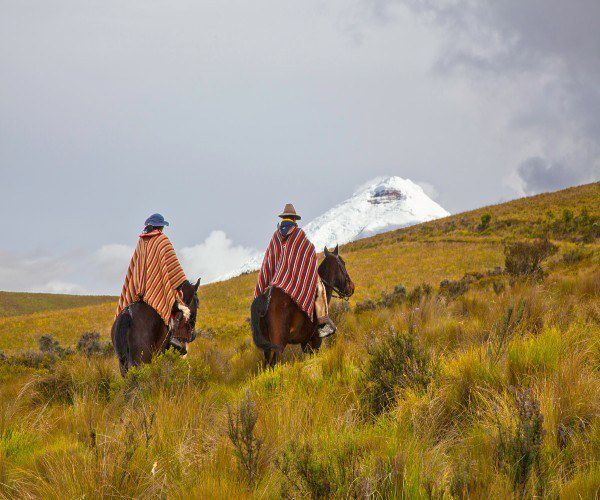
Cotopaxi is the second-highest active volcano, and its name means “neck of the moon” in Kichwa. This fantastic reserve offers the opportunity to go on many activities like hiking, climbing the summit of the Cotopaxi, and horseback riding. This activity lasts around 4 hours and it is essential to consider that it will be done over 3000 meters above sea level, allowing you to see the natural flora and fauna of the paramo as you’ve never imagined it before.
Hike the Pasochoa Volcano
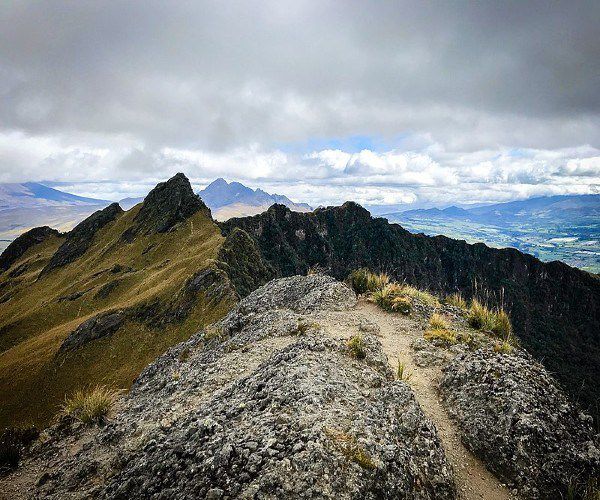
This extinct volcano has been inactive since the last ice age. This volcano can be easily reached by driving from Quito in a 4×4 vehicle. The hike is relatively easy and it allows you to spot birds, horses and the occasional Andean Condor. If you have luck, this 5-hour hike is the perfect opportunity to enjoy a full day of activities without needing too much experience with outdoor activities.
Biking in the “Paseo del Quinde”

If you are not only a biking enthusiast but also love birdwatching, then this is the perfect route for you. The road starts from Quito, and you will need to start biking from the town of Nono until you reach the village of Mindo. Between these two towns, there is an altitude difference that will allow you to see the variety of vegetation and wildlife.
Go on a canopy adventure in Mindo
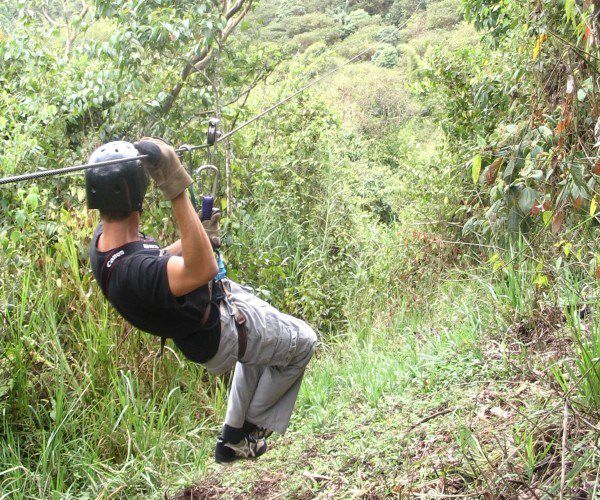
If you decided to follow our recommendation and went biking from Nono to Mindo, then sleeping in Mindo is the best idea. For the following day in Mindo, it is recommended to either relax or explore the town and go for another adventure.
Mindo’s lush subtropical ecosystem is known for its biodiversity and birdwatching opportunities. Its lush forests are not only home to more than 500 types of birds but are also the perfect place to go on an exciting activity like zipline canopy between the dense trees.
This can be easily done by hiking to the are where the zipline is; no special gear is needed on your side. Just keep your eyes open to spot some toucans while you are in the air!
Conquer the summit of Rucu Pichincha
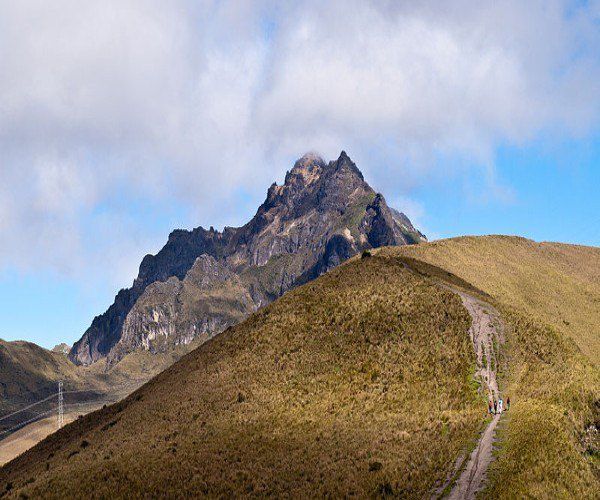
This urban volcano is an everyday presence for those who live in Quito. Rucu Pichincha is an older and lower summit that can be accessed when taking Quito’s cable car, also known as the Teleferiqo. From Quito, the altitude is 2800 meters above sea level, the Teleferiqo will reach further to 3900 meters and the summit of Rucu Pichincha is at 4390 meters above sea level. However, the heights can be frightening; the hike will last between 3-4 hours through a well-marked trail. A worthy urban adventure!
By Carlos Beate
Immunity boosting retreats in Asia

One thing the COVID-19 pandemic has taught us is that health is wealth. Taking good care of ourselves both physically and emotionally during these challenging times is essential. Yet, when travel resumes, is a simple beach holiday really going to be enough?
Immune boosting retreats
Immunity is the body’s innate ability to fight off disease. Ensuring that our immune system is optimal to ward off disease can help us to feel vibrant and healthy. Luxury wellness retreats to boost the immune system and prevent disease were popular pre-pandemic. With time to consider their health and wellness offerings, Asia’s luxury health resorts are now re-positioning their retreats to help clients heal and feel well again. Asia’s holistic approach to health is ideal for those who want to feel their best again. Whether the aim is to detox and lose weight gained whilst in lockdown or to address the emotional issues experienced during isolation, Asian wellness retreats offer authentic wellness journeys.
Life reset in Thailand

The serene, tropical beaches of Thailand are waiting as challenging times call for personal growth. Thailand pioneered luxury wellness when it opened the doors to Chiva Som in 1995. A contemporary resort with traditional Thai design, this luxury retreat offers programs which focus on the six wellness modalities of Physiotherapy, Holistic Health, Nutrition, Fitness, Spa, and Aesthetic Beauty. Wellness programs such as ‘Emotional and Mental Balance’ and ‘Mindfulness’ address the anxiety we commonly feel these days and more physical fitness retreats get the body moving and usher in new, healthier habits.
Centred around an ancient meditation cave and sloping gently towards the sea in Koh Samui, Kamalaya has long held a flexible approach to health and wellness. Adding to its already robust health program is a new ‘Immunity and Resilience’ program. Ranging from 7-21 nights, this new luxury wellness retreat was specifically created for post-pandemic travel. With Asia’s uniquely holistic approach, physical issues are identified via functional blood testing and nutritional guidance, herbal supplements, and Traditional Chinese Medicine. Mindfulness training, private meditation, and Bioresonance therapy provide an emotional toolkit to begin to face new challenges with increased confidence.

After periods of uncertainty and isolation, it’s natural to want to press the reset button and that’s exactly what luxury resort Amanpuri in Phuket promises. Aman resorts have long supplied their dedicated guests or ‘Aman junkies’ laid back luxury in breathtaking locations across Asia and beyond. Dipping their toe into wellness a few years back proved a fantastic fit for their loyal luxury following. Their ‘Life Reset’ immersion is designed to transform you from a state of exhaustion on arrival to one of balance and positivity. Carefully curated to offer nutritional guidance and stress management techniques, every experience is tailored to each guest’s personal needs.
Remote healing in Bhutan

Bhutan, known as ‘The Land of the Thunder Dragon’ is hidden away in the Himalayas. It was sheltered from foreign tourists until 1974 and still restricts the number of visitors allowed within the country. A country which bases its success on Gross National Happiness is surely a healing retreat for the future!
The landscape in Bhutan is breathtaking; from snow-capped, Himalayan mountain ranges, scattered with Buddhist prayer flags to verdant valleys dotted with ancient monasteries and temples. If you’re looking for a remote and authentic experience, Bhutan is second to none.
Aman luxury lodges offer the ability to traverse the breadth of this mystical land while enjoying the luxuries of 5-star service and accommodation. With lodges across the five valleys of Paro, Thimphu, Punakha, Gangtey, and Bumthang, Aman is perfectly positioned to delivered personalised spiritual and cultural vacations in Bhutan.
One of the most unique openings of current times in Bhutan is a wellness sanctuary dedicated to providing lasting positive changes in its guests. Bhutan Spirit Sanctuary is the country’s first dedicated holistic health and wellness retreat. Guest stays feature all-inclusive Bhutanese spa treatments and facilities with an indoor heated pool complete with floor to ceiling glass doors, offering a stunning view of the surrounding mountains and valley. With Bhutanese Traditional Doctors on staff, the sanctuary can also offer unique healing treatments to boost immunity on tap and they are well connected to local monasteries. Working in tandem with luxury wellness travel companies, they offer personalised retreat experiences tailored to individual dreams. From trekking and hiking to meeting monks and attending auspicious ceremonies, anything is possible in Bhutan.
Balinese healing

The ‘Island of the Gods’ has long attracted travellers from all corners of the earth, seeking spiritual connection and healing. Its verdant rice paddies, daily Hindu rituals, and a plethora of yoga and meditation centres appeal to those seeking more than a simple beach hangout. When tourism exploded in the ’70s, Bali became a surfer’s and backpacker’s paradise. Today, Bali offers something for every pocket and luxury travellers are well catered to. Blending the naturally nurturing hospitality of the Balinese with creative architectural design, health and wellness sanctuaries such as COMO Shambhala Estate were born. Resident health experts include a yoga teacher, Ayurvedic doctor, and resident Dietician. They form a team, guiding each guest on a personal journey to renewed vitality and wellbeing. Set within a lush jungle sanctuary, it’s the perfect place to unwind and feel more balanced. If the beach calls, Revivo, set on the edge of a tropical teak forest above the Indian Ocean on Bali’s southern coast, offers a ‘Press Reset’ program. Aimed at removing self-limiting beliefs, the retreat includes mindfulness, yoga, healthy cuisine, and healing massage.
Eco-conscious luxury wellness retreat Fivelements is a bamboo sanctuary on the banks of the sacred River Ayung. Situated just on the verge of Bali’s spiritual centre Ubud, the retreat is deeply rooted in the ancient traditions of Balinese healing. Authentic healing treatments are offered by local Balinese priests and the resort’s plant-based ‘living’ cuisine is also a highlight. Immunity-boosting retreats include ‘Tri Kaya Parisudha’, a holistic detox and ‘Panca Mahabhuta’, a spiritually healing program.
Healing in the Himalayas

The source of ancient healing techniques for disease prevention lies in India. The birthplace of Ayurveda and yoga, India lives and breathes wellness and spirituality. In terms of luxury health resorts, Ananda in the Himalayas leads the way. Ananda is set within the foothills of the Himalayas on a hundred-acre Maharaja’s Palace Estate. Surrounded by forest, it faces the spiritual town of Rishikesh and the sacred river Ganges. Flights from Delhi to the local airport Jolly Grant, are then followed by a picturesque drive to the resort. All very well worth the travelling time. Wellness retreats are created around the ancient principles of Ayurveda and, as travel resumes, a rejuvenating ‘Ayurvedic Immunity Booster’ program is available. Immunity boosting yoga and Ayurvedic remedies help to increase energy and metabolism, leading to increased vitality and wellbeing.
Vietnam is one to watch

Vietnam is a stunning sliver of a country on the Eastern side of the Indo-Chinese peninsula. Although there are many luxury hotels throughout the country, the luxury health and wellness industry is still in its infancy. Luxury resort Amanoi rests on tranquil Vinh Hy Bay in Southern Vietnam, overlooking Núi Chúa National Park. It features a divine yoga pavilion which rests above a lotus flower covered lake, private beach, and luxury spa. Wellness immersions include weight loss, detox, and mindfulness retreats.
A healthy holiday in Asia, some beach luxury and pampering, or a remote spiritual trek to reconnect may currently all be only a dream. In the meantime, be gentle, healthy, and happy while the opportunity to reconnect with self and others awaits.
By Joanne McFarlane
Discover the beauty of Siwa in Egypt

Siwa Oasis is an amazing and magnificent oasis found between the Qattara Depression and the Great Sand Sea in Egypt. It’s such a popular tourist attraction that it was given the name of Oasis of Amun Ra due to its role in Ancient Egypt as the home to an oracle of Ammon. There is a richness in culture as well as beauty in its nature. The best time to visit the oasis is during the Wintertime for you to get the best experience out of your trip.
Indulge in Siwa’s never-ending adventures

Siwa Oasis holds many different attractions for you to see and to start you off there is the Temple of the Oracle of Amun which was believed to have been built by Alexander who was officially named the son of Amun. It is the most significant temple built in the Egyptian desert in its time and was dedicated to Amun who was the God of the desert.
Another amazing sight is the Mountain of the Dead where tombs cover most of the mountain. The tombs were built ever since the 26th dynasty and Ptolemaic and Roman times. In the very middle, you can find the Ancient Tombs of the Pharaonic King and his family members. You can also climb to the peak of the mountain to see a panoramic view of Siwa.
Visit the Shali Fortress to find ruins built with a mix of clay and salt called Karshef. You can climb up for a beautiful view of the oasis or enjoy the handcraft shops you will find going down with many unique goods at reasonable prices.
Next, you can visit the Museum of Siwan Traditions which is located in a traditional Siwan house. It holds many traditional objects including jewelry, musical instruments, costumes and ceramics. This house was built by a Canadian diplomat to help preserve and display many of Siwa’s artifacts.
Cleopatra’s Pool is where Cleopatra used to water as her natural bath and has now been surrounded by Arabian Desert themed cafes and local shops, and it is a sight to witness. Enjoy swimming in the popular natural warm groundwater or sit at one of the amazing cafes playing beautiful music.
Looking for fun activities in Siwa?

Two things you cannot miss are the sand-boarding and safari trips done in Siwa. The Great Sand Sea safari is sure to be one of the most exciting safaris there is. You can also camp in the desert to watch the starry nights and have a chill evening toasting marshmallows, or have Siwian desert tea and a delicious meal while you’re watching the sunset in the middle of the desert.
For a means of transportation, try renting a bike or hop into local tricycles to take you on a tour or wherever you need to go. Also, don’t miss a chance to taste the deliciousness of locally produced foods such as dates and olives, which are Siwa’s primary crops. Another amazing place to eat is Abdu’s Restaurant, located at Siwa’s Market Square. Known for not only a great dining menu, but also a delicious breakfast menu.
Discover the Taghaghien Touristic Island; a beautiful African-themed village in the middle of the lake in Siwa. The entire island is handmade, even the bathrooms are made with desert stone. It’s a unique experience to enjoy a night in one of the African houses, with nothing but moonlit lake and desert to surround you.
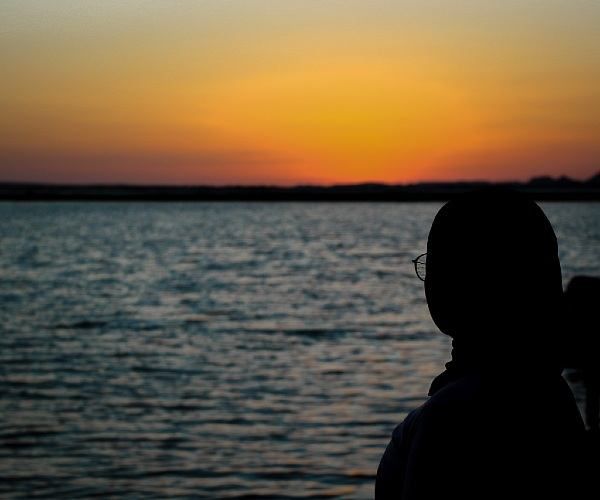
Book a night in Siwa’s Ecolodge Adrere Amellal – a beautiful hotel made entirely out of mud and salt with no electricity, but is only candle-lit. It’s the perfect getaway as it is built away from the town, so you can have the chance to meditate and disconnect from anything and everything around you.
Attend the at-Tagmigra festival or a Sufi Dhikr circle, both very different. The festival is held after corn harvest in the Summer, where Dhikr is performed outside the small tomb shrine of Sidi Suleiman. On the other hand, the Sufi Dhikr circle is a gathering held each Thursday where Sufists immerse in prayers and chants. These gatherings are of spirituality which is why you have to show respect to this aspect if you wish to attend.
Whether you’re interested in visiting historical attractions, or just planning a trip to experience the adventurous side of the oasis, you will not regret the beauty of it as it is something you don’t witness in everyday life. Don’t forget to buy local souvenirs to help you remember an already unforgettable trip.
By Sherif Khalil
Great activity ideas while staying in at your private villa
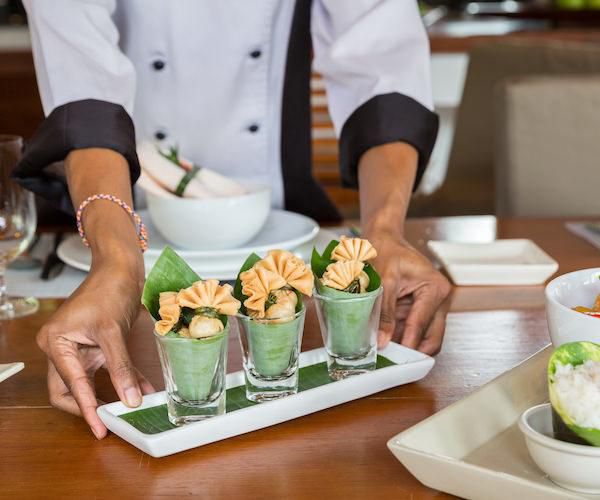
Luxury villas are seen as an ideal choice of accommodation with their offering of complete exclusivity where families or groups of friends can stay and enjoy resort-class amenities all to themselves. But with a dedicated concierge who can arrange activities for you and a professional staff ready to assist with your holiday plans, there is just so much that you may not have thought about what you can actually while staying in.
Here is a list of amazing group activities to keep everyone occupied and boredom-free during your vacation – all of them without having to leave your villa.
Cooking master class with your villa chef
One of the most notable perks of staying at a luxury villa is having your own private chef. Though many are happy just to feast on culinary delights, guests who wish to learn a thing or two are also welcome to step inside the kitchen.
Pick-up new techniques, discover new ingredients, and add a new dish to your list of know-hows. Many villa chefs even offer cooking classes that come complete with official certificates.
Cocktail party with a professional mixologist

If you’d rather not go out to a crowded bar, why don’t you just bring the bar right to your villa? Invite your own personal bartender for an afternoon of delightful cocktail creations. Some villa staff are trained mixologists too.
Set up your in-house party at the poolside pavilion, rooftop deck, or entertainment area and spice it all up with mood music from the villa’s built-in sound system. For a more intimate experience, some villas feature their own wine cellar where guests can fancy a wine tasting session and kill time with memorable conversations.
Yoga session in complete tranquility
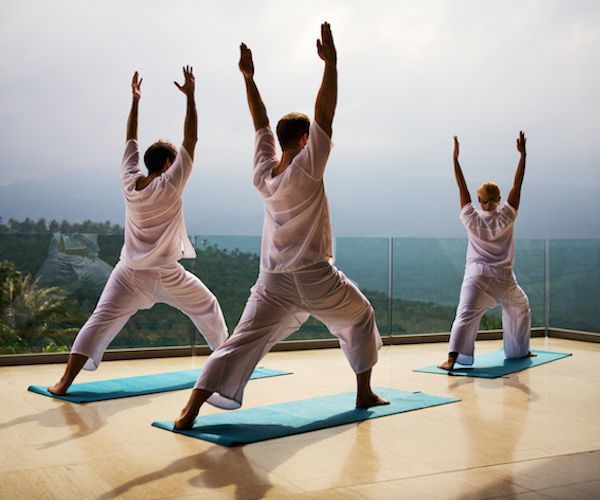
Providing peaceful seclusion with truly breathtaking views, luxury villas make the perfect venue for yoga. Many of these properties include complimentary yoga mats and yoga blocks. Some even come with a dedicated yoga platform.
Guests can also request a private yoga instructor to come to the villa. Play your choice of mediation music in the villa’s sound system or simply listen to ocean waves and let your mind drift into utter bliss.
Poolside barbecue fiesta
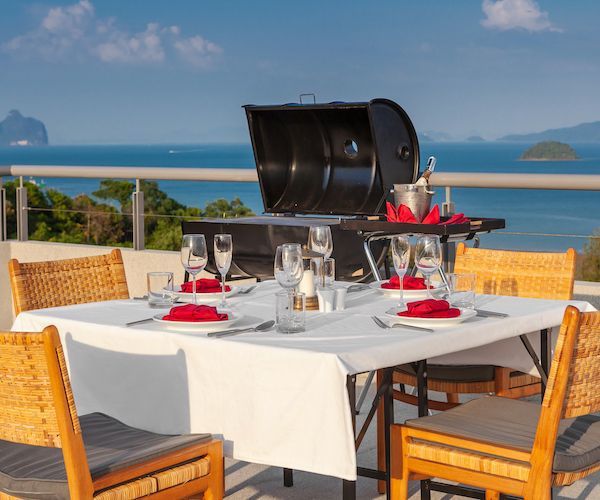
Fancy dining is a given when you are at a private villa, but there is a special enjoyment with the traditional outdoor cooking with friends and family.
Whether you go for seafood, meat, or veggies, a barbecue fiesta is a sure winner for groups wanting to compliment fun time outdoors with good food. Many villas come with poolside dining areas with a bar and barbecue grill.
Movie night!
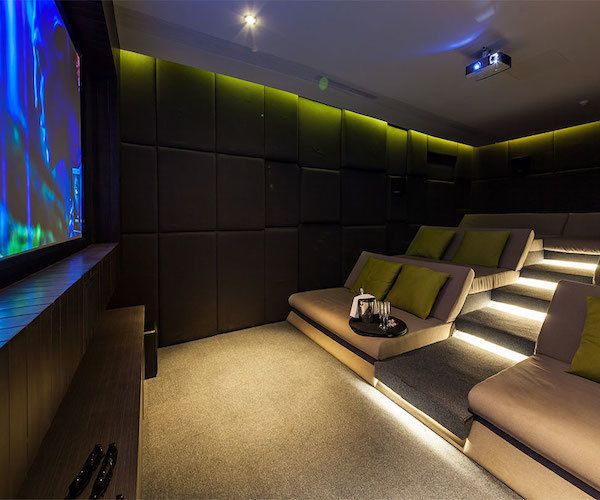
There is no guilt in binge-watching when your home rental comes with its very own home theater. And with hundreds of movies and shows in store, you can never run out of choices.
Make movie nights more exciting by setting a theme or create a watch list with recommendations from each member of the group. Your villa staff will happily prepare the popcorn and snacks for everyone too.
All-out gaming bonanza
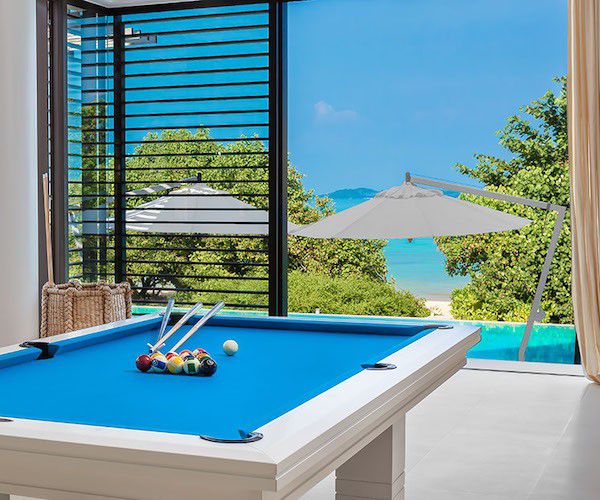
Outdoor sports, indoor sports, board games, or computer games – your private villa has something for the old, the young, and the young at heart.
What else could be more fun and challenging at the same time than a friendly competition with your loved ones? Such activity is sure to rekindle bonds and loosen up everyone.
Finish the day with a relaxing spa treatment
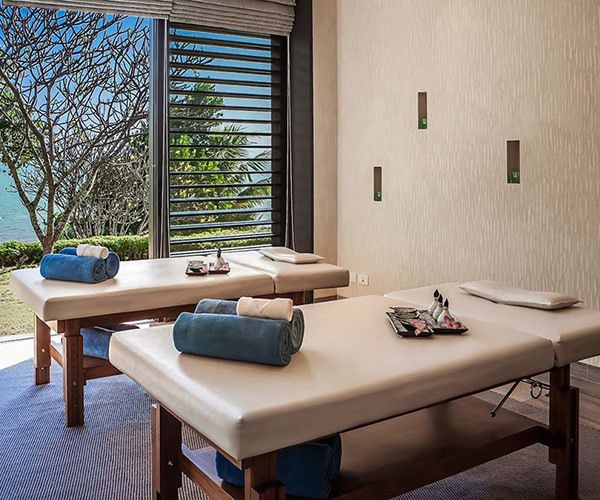
An in-villa spa treatment is a quintessential cherry on top of any villa vacation. A common favorite among guests, private massages can be easily arranged for groups.
Some villas have their own spa rooms complete with saunas or hot tubs. They can also be done in the comfort of your bedroom.
Capture your vacation memories with a photoshoot
It is quite common that villa vacations coincide with celebrations such as anniversaries or reunions. The memories of your stay are surely worth remembering. Schedule a photoshoot with a professional photographer or videographer. Add some creativity by choosing a dress code or explore wonderful angles and poses you can do in the different locations within your villa.
By Silvan Kitma
Wellness weekend in Austin
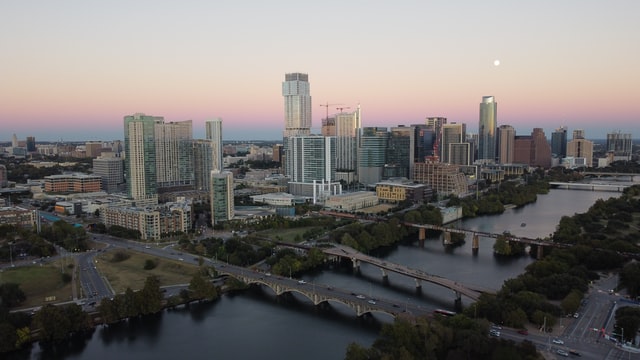
Austin isn’t all hipster bands and breakfast tacos. Although to be fair, there are a lot of those. The tech world of Austin has quietly boomed, and flocks of bright young things in athleisure from around the country—and the world—have moved in. An abundance of healthy-ish restaurants, workout studios, and wellness-forward hotels have followed. And while we stan for newness, innovation, and a great yoga class, Austin’s glory has always been…Austin. It’s the greenest city in the Lone Star State. There seems to be a park on every block (in fact, 286 of them) and a trail for every bike. Then there are the lakes. So. Many. Lakes. On a recent trip to ATX, we decided to skip Franklin’s meat and three, late nights at the Continental Club, and cheesy migas at Veracruz. Instead, we laced up our sneakers. We scoured the city for cleaned-up versions of our breakfast favorites, we found the dreamiest spots for a refreshing dip, and we decamped to the Texas Hill Country to decompress among the wildflowers. And we fell in love with a whole new side of the city.
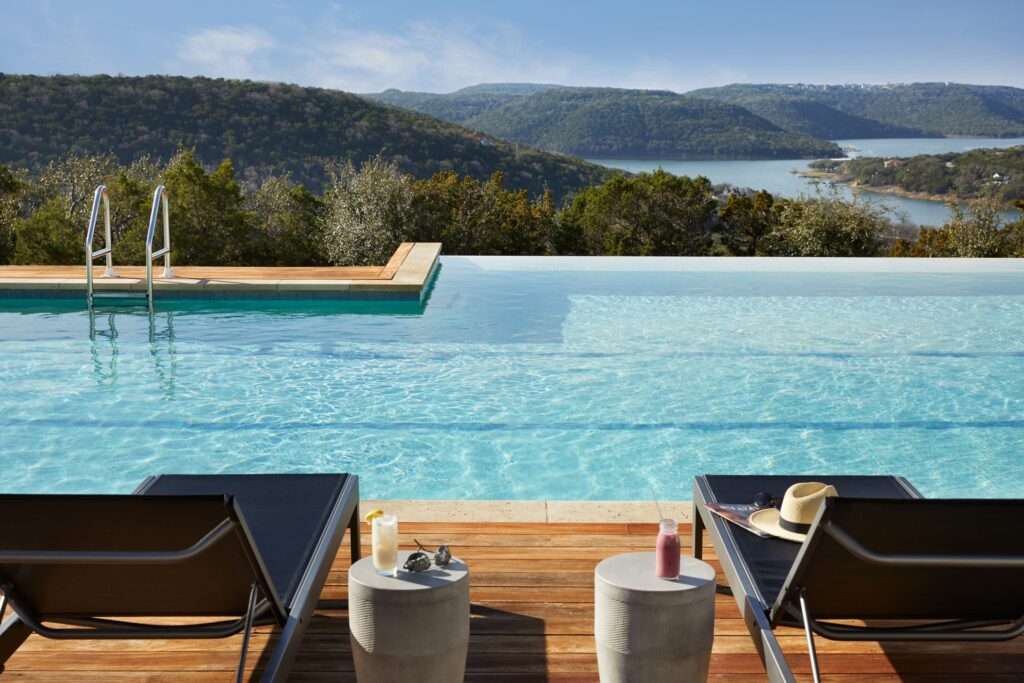
CHECK-IN
Miraval really leans into the idea that everything is bigger in Texas. The 220 acres of wildflower-and-cactus-laced parkland are only thirty minutes from Austin’s main arteries. This latest addition to the Miraval portfolio is a counterbalance to the city’s techy buzz and BBQ vibe. A weekend here, among the bluebonnets of Texas Hill Country, is about unplugging. No loud talking on the phone (there are designated phone zones) and no smoking anywhere. When you arrive, the smoky scent of wood fires drifts through the lobby, and the rustic minimalism and sheer expansiveness of the property invite you to unwind. It’s impossible to feel stressed in a place this calming. While the practice of wellness and self-care can often feel like a competitive sport, the Miraval team has created a beautiful, non cheesy wellness wonderland. Everything is saturated with natural light, and guest rooms—all in soothing shades of grey, sand, and cream—come stocked with meditation cushions and Tibetan singing bowls. (Tibetan singing bowls!) The A-frame yoga barn is so peaceful and soothing that it’s worth taking a class even if you don’t like yoga. Even the animals are calm. Horses never clip-clop any faster than a gentle plod, and rides are more an exercise in meditation than adrenaline. Mornings can be spent beekeeping (yes, really) at Miraval’s on-site apiary, collecting eggs from the coop, and learning about medicinal mushrooms—all grown (chemical- and pesticide-free) on the property.
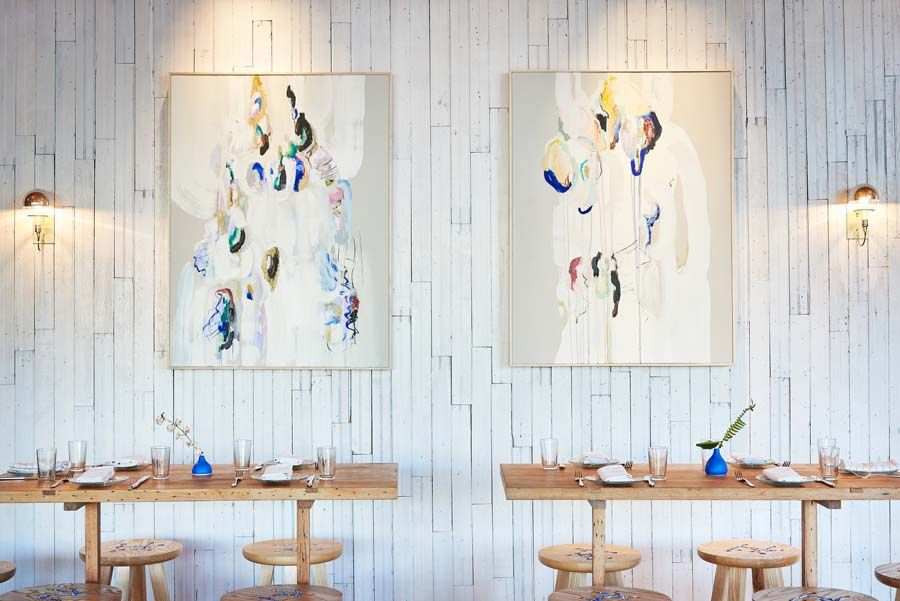
WHERE TO EAT
The prospect of flaky, yummy ham-and-cheese croissants at Café No Sé is enough to pull us from Miraval’s cloudlike beds and into central Austin before 10 a.m. Locals crowd around tables for group brunches, while solo diners rustle through the newspapers with cold brew and quinoa porridge for company. Meanwhile, BLTs, smoked salmon, and herby-cream-cheese-smeared bagels are exactly what we want to eat before noon pretty much every day of the week. And while it may be unexpected, chef Amanda Rockman’s crunchy, green breakfast salad, doused in turmeric vinaigrette, is the crucial component to our order every time. When it comes to dinner, Barley Swine works its magic with a fresh-off-the-farm bounty like no place else. And we’re obsessed with the locally made Sunset Canyon pottery each dish is served on. A healthy-ish dinner could look like this: bean salad with masa-infused mayo, shishito pepper mousse flecked with puffed grains, and a bowl of shiitake dumplings with grilled squash to share. (If all the walking, juicing, and namaste-ing has left you craving butter and salt, order the sweet corn dumplings at Suerte. You won’t be sorry.)
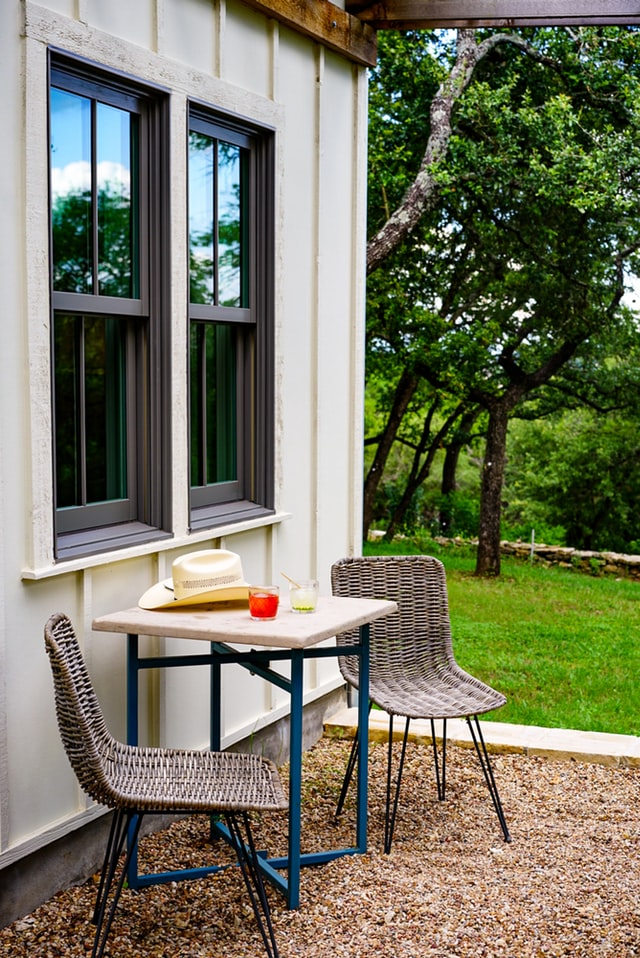
WHAT TO DO
Austinites are an outdoorsy lot. And while being outdoorsy in a place with regular highs of ninety-plus degrees seems torturous, after a few days, you start to get it. The city is teeming with pockets of green, manicured trails, and public pools. The Ann and Roy Butler Hike-and-Bike trail is easy to love. Ten miles of the best people-watching in town loops around Austin’s sparkling crown jewel: Lady Bird Lake. (Replenish your electrolytes at Juiceland on Barton Springs Road. We’re partial to the Blue Hullabaloo, a blend of hemp milk, banana, Blue Majik spirulina, lemon, and coconut oil.) When you get sweaty hot—and you will—Austin is ready for you. Barton Springs Pool has the dual advantage of stemming from real natural springs and being surrounded by a veil of trees that give it the feel of an oasis. Across the Colorado River, a splash at Deep Eddy Pool on a fiery Austin afternoon is sweet (cool) relief. Once you’re all refreshed, it’s time to shop. In recent years, Austin has transformed into a retail nirvana (hello, Sunroom and ByGeorge), but Take Heart was a new find for us. Behind the minimalist all-glass storefront is a cornucopia of wellness-leaning giftables, like rose quartz gua sha tools and essential oils. We couldn’t look away from the more design-y pieces, especially the sculptural incense burners and robust maple chopping blocks. A slow amble through Keith Kreeger’s studio and showroom over on Springdale Road is like taking in an exhibit. Each hand-thrown vase, cup, and serving dish is a thing of beauty and made to last. (And made to be brought home, in our opinion.)
Historic hotels in England

Across England‘s green and pleasant land, dozens of historic hotels reveal chapters of the nation’s rich and often turbulent history. Over the last century, many grand country houses have been saved from ruin and reborn as luxurious hotels.
Once, these houses were the aristocracy’s zealously guarded bastions, not that every one of these houses was once a family home. Today, these hotels and their superb restaurants offer a warm welcome to those who wish to escape from frenetic life into more leisurely times.
Stanbrook Abbey Hotel, Worcester
Stanbrook Abbey Hotel, a former Benedictine Abbey, with architectural hints of the Houses of Parliament, is a slice of English history that has been transformed into a luxurious country retreat.

It’s worth taking the 145 steps of a spiraling stairway to the top of the 100 foot Bell Tower to look out over Worcestershire’s patchwork of fields and hills.
Once the Pope had deconsecrated the Abbey, after the nuns had relocated to Yorkshire for greater peace, Handpicked Hotels undertook a remarkable £4.2 m transformation, with a tall contemporary addition housing reception and a vast bar.

Yet, history is celebrated with the feature bedrooms commemorating the craftsmen who contributed to Abbey’s original glory: Ashton, Boulton, Pugin, and Thompson. Look out for the woodwork of Robert “Mousemen” Thompson, who incorporated mice into his carvings.
The Swan Hotel and Spa, Newby Bridge
Since 1651, the Swan Hotel, initially a coaching inn, has looked out over the picturesque five arches of a single-track bridge across the river that flows into Lake Windermere’s southern tip.

Just fifteen minutes from the M6, The Swan Hotel, with its riverside weeping willows and lacy white wrought-iron garden furniture, makes for a stylish gateway to the Lake District.
Featuring a marina, spa, indoor swimming pool, adventure playground, and nature trail, The Swan is a destination for all families.

The Signature Restaurant, daringly decorated with cerise banquettes and filament-raw dangling lighting, provides many local specialties, including Morecambe Bay potted shrimps, a local take on chorizo, and sticky toffee pudding.
Homewood Hotel and Spa, Bath
Long ago, the Romans brought art, civilization, Mediterranean living, and indulgent bathing to Bath. Centuries on from the Romans, Homewood, just south of Bath and overlooking the bucolic Avon Valley again brings all of these – plus chic contemporary style – to this Cotswold stone house, portions of which date back to a 13th century Carthusian monastery.

With a fire-place and patio heaters, sheltered by soaring trees, the Olio Terrace extends the British spring and autumn for al fresco breakfast, lunch and dinner. While the pool and hot-tub also bring a Mediterranean aura to Bath.
Tapas menus contribute to the Mediterranean vibe, too: family and friends share small plates such as chili squid, griddled prawns, and chorizo scotch egg. Salmon, chicken, and steaks can either be cooked robata, plancha or skillet. Guests, casually but stylishly dressed, love the sophisticated Ottolenghi-style salads: think caponata, pine nuts, red wine vinegar, and bulgur wheat.

Ian Taylor, the owner, is an art enthusiast: don’t miss Reception’s clock collection or the atmosphere black-and-white 1970s photographic portraits of musician Peter Gabriel, displayed beneath the diverse chandeliers of the dining room.
Middlethorpe Hall Hotel and Spa, York
If at this red-brick and white-sash windowed house, built-in 1699, you feel that you are living in a National Trust House, your senses are not deceived.
Middlethorpe Hall sits on the outskirts of York and its attractions of the Minster, the Shambles, and a trip into Viking days. Yet, guests often slip into England’s rich history, forgetting the outside world, when staying at this elegant property run by Historic House Hotels and owned by the National Trust.

Guests relax amongst the dark wood bureaux, gilded mirrors, countless side tables, and four-poster beds in some rooms, historically dressed in sheets, blankets, and eiderdown.
A National Trust leaflet guides walkers around the 20 acres of trees planted centuries ago, the lake with pike and perch, croquet lawn, and walled garden. Coffee, lunch, afternoon tea, and pre-dinner drinks can all be taken on the flagstone terrace looking across the striped lawn and onto the parkland.

Increasingly, the AA two rosette restaurant, with original 1699 wood paneling, looks to source from local suppliers of fish, game, and meat. Also, home-grown produce from the Walled Garden appears more and more on the menu.
Hampton Manor, Hampton-in-Arden
Finally, within 45 acres of Hampton-upon-Arden, once a green swathe of Shakespeare’s Forest of Arden, Hampton Manor looks both to the past and the future.

Another Neo-Gothic country house, this time built by Frederick Peel, son of once Prime Minister Robert Peel, revives the country house’s spirit with two-night breaks. A tasting menu in the Michelin-starred restaurant is at the heart of the experience. However, another dinner served in “Smoke,” a greenhouse, magically transformed into a unique restaurant, is a memorable experience.
Guests may arrive as strangers, but a Hampton stay a sociable event as people bond, if they wish, over pre-dinner cocktails, roasting marshmallows after dinner by the fire pit, whisky tasting, a bread-making course, wine tasting, and a tour of the walled gardens.

The Hill family, who run Hampton Manor, has a vision of organic and regenerative farming where waste is minimized. So the “Wasted” gin in the bar is distilled from recycled coffee beans. Typically a silky carrot soup from carrots grown just yards away is accompanied by an inventive pesto of carrot tops – which otherwise would have been wasted. Wherever possible, the Hampton Manor kitchen adheres to its guiding principle: “nothing added, nothing taken away.”
by Michael Edwards
Hurghada opens its first Pharaonic museum in Egypt
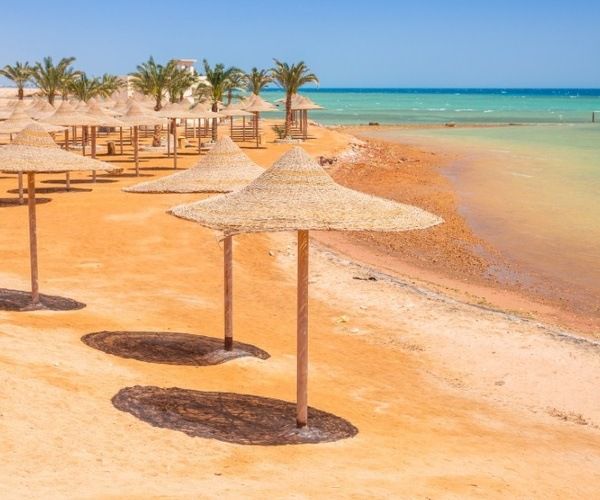
Here, we will take you over the years… back to the pharaonic era yet in one of the most charming cities in Egypt – Hurghada.
Hurghada is a beautiful city perfectly located in the Red Sea Governorate of Egypt; one of the major tourist centers only 400 km from the capital. It is one of the main tourist cities on the Red Sea coast; it’s known for its watersports, cool activities, soft sands, amused nightlife, and warm weather. Many visitors head to Hurghada for an outstanding vacation, especially during the winter season in Egypt.
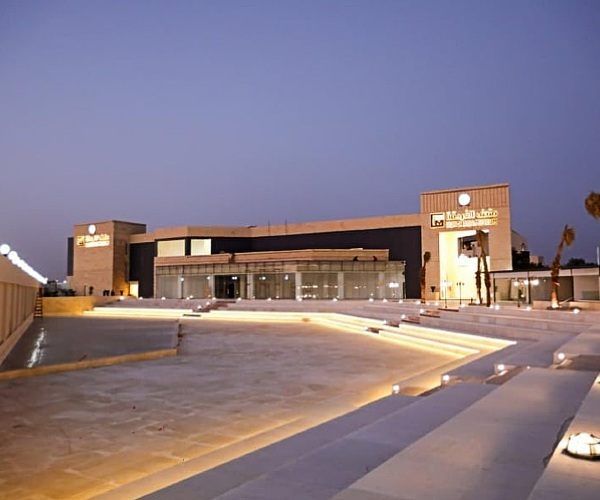
Recently, Hurghada is about to add more adventure to its program and offer its visitors a little different experience: a Pharaonic Museum. The new Pharaonic Museum in Hurghada is completely designed to meet world-class museum standards! It features a mixture of the artistic and the prosperity sides of the Egyptian civilization throughout thousands of years; around 1000 pieces of the artifacts to be displayed in the museum in order to attract more tourists to visit the Hurghada. It is not only the first antiquities museum in the Red Sea Governorate, but also the first Egyptian museum that is the result of a joint project between the Ministry of Tourism and the Ministry of Antiquities, The Red Sea Governorate and the private sector investors. The museum has a customized entertainment area, shopping complex, and parking lots. It cost around EGP 160 million ($10 million).
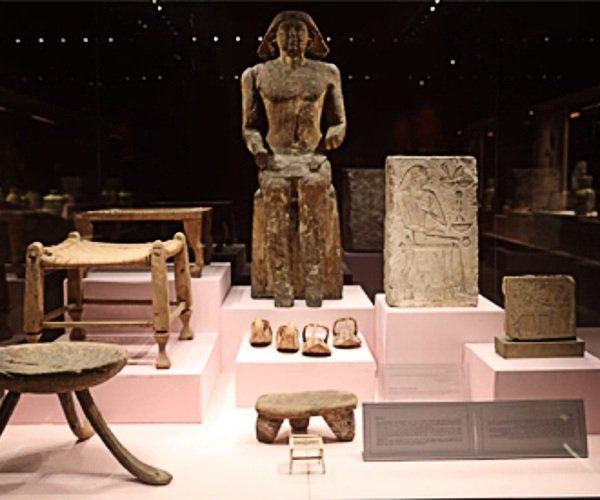
Moreover, Hurghada Museum will also offer some ancient sports activities, including river fishing and hunting, as well as music and dance events; scenes from old dances and musical performances from the Pharaonic era to modern times are on show. Performance models showing how it was made and how ancient Egyptians decorated their tombs are exhibited. The museum is set to encourage beach lovers to visit museums during their vacation in the coastal areas of Egypt.
Get ready to enjoy your next tour in Hurghada, Egypt; explore the great Egyptian civilization from different eras and experience the breath-taken Red Sea waters just in one place, Hurghada.
The museum is located in the south of Hurghada; a few minutes away from the Tourists’ Promenade and Hurghada International Airport. It occupies 3000 M² on a 10.000 M² property. It features 6 main departments:
The Pharaonic Cemetery: The main hall of Hurghada Museum contains a pharaonic cemetery designed to simulate the mountainous nature of the tombs and contains coffins and pharaoh mummies.
Pharaonic Age: it shows the Pharaonic Era dates back to 3000 years B.C. till Alexander the Great conquered Egypt in 323 B.C.
Greeco Roman: It shows the period of Greek history in Egypt when Ancient Greece was dominated by the Roman Republic (509 – 27 BC), the Roman Empire (27 BC – AD 395).
Islamic Era: It shows the Islamic Age with its cultural, economic, and scientific flourishing in the history of Islam, dated from the 8th century to the 14th.
Coptic Era: shows that informal designation for Late Roman Egypt and Byzantine Egypt. This era was defined by the religious shifts in Egyptian culture to Coptic Christianity from ancient Egyptian religion.
Modern Egypt Era: shows the Modern Egypt Era dates from the emergence of Muhammad Ali’s rule in the early 19th century and his launching of Egypt’s modernization project.
Hurghada Museum also offers many world-class facilities including, shopping area, Egyptian Folkore, restaurants, cafes, kids’ area, and photo studio.
Tourism and Antiquities Minister – Khaled El-Anany – said that the museum would also include a section to display the cultural heritage and monuments of the Red Sea.
The Museum comes to light over 10 years since it was announced — and is set to be the first of its kind in the Red Sea. It was among several projects that were put on hold due to the January 25th revolution. As it isn’t the only pharaonic museum in a coastal city; the Egyptian Ministry of Antiquities has been working hard to refresh the tourism sector in the country, especially after the current global lockdown. They’ve built another museum in Sharm El Sheikh City, which is also set to open its doors soon.
Hurghada Museum is one of the most prominent projects implemented by the Ministry of Antiquities in partnership with the private sector in Egypt, which provided the museum’s building. That makes it the first museum to be opened in partnership with the private sector! The Ministry of Antiquities will be the only entity managing and supervising the museum.
Author : – Sherif Khalil
Great beach bars and restaurants in the Caribbean
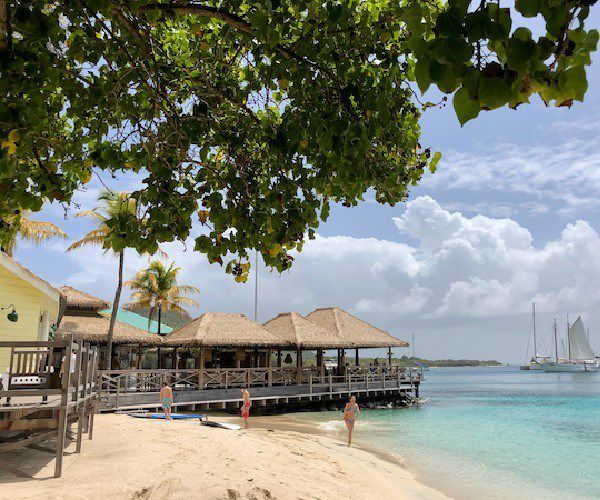
There is something therapeutic about looking out towards the sea. I appreciate those restorative ocean view therapy sessions even more now, not having had access to them, and not having a clear idea of when I might again. Those who are drawn to the sea will always find a way go back, I am confident. For the time being, I will be content to reminisce about beach trips of the past, and continue to dream up ones for the future.
When it comes to assessing beach bars, suffice it to say that I have a few baseline requirements: a vibe that pairs naturally with the island’s culture, is a good place to start. A combination of tourists and locals, to add credibility, authenticity, and a festive air. The food should be at culinary level that seems to match up to the establishment’s look, vibe, and atmosphere. And lastly, a USP (Unique Selling Point) that makes me yearn to go back, months after the holiday has ended.
With the exception of Anegada, I’ve been lucky enough to visit the following five spots more than once. That qualifies me as an expert. An expert in my own personal experiences, that is.
This list is in no way complete, and happily so. While I have been to a fair share of Caribbean islands, I long to explore more—to seek out hidden bars, barefoot-chic dives, and even tourist-infused, swanky, beach restaurants that are tucked away in this idyllic part of the world.
5. Basil’s Bar, Mustique
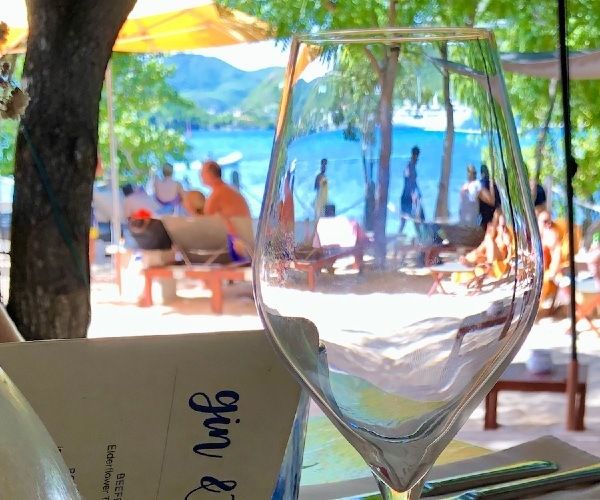
Island vibe: Understated hideaway
Perched effortlessly on the edge of Britannia Bay in Mustique, Basil’s attempts to camouflage the undercover glamour of this exclusive island. Home to media moguls, models, and celebrities— Mustique’s beauty is hiding in plain sight among the breezy Windward Islands.
Why did Basil’s make the list? Uber-chill Basil’s woos a combination of villa owners, fisherman, and yachties alike, with its trifecta of simple, casual food, a low-key atmosphere, and dazzling sea views. Some might say it is now too popular, too overrun with tourists, and not the well-kept secret hideaway it used to be. Secrets in the Caribbean are not secret for very long, and new secrets are likely already in the works. Yet, I can attest, that with super yachts and schooners anchored in the distance, (an added layer to the already swoon-worthy backdrop), Basil’s still delivers.
USP: A series of connected, simple, thatched huts, and open-air dining spaces, extend the invitation to settle in, with Basil’s signature drink, Hurricane David, while the sun starts its fiery descent. Famous for its Wednesday Night Jump Up, and Sunday Night Sunset Jazz on its sandy dance floor, there is feasibly no bad time to kick off your shoes at Basil’s Bar.
4. Catherine’s Café, Antigua

Island vibe: European escape
To say Catherine’s is comfortable in her own skin is an understatement. Louvre-shuttered, sea-breezy Catherine’s Café on the island of Antigua, lazes about under her warm, butter-yellow Veuve Cliquot umbrellas.
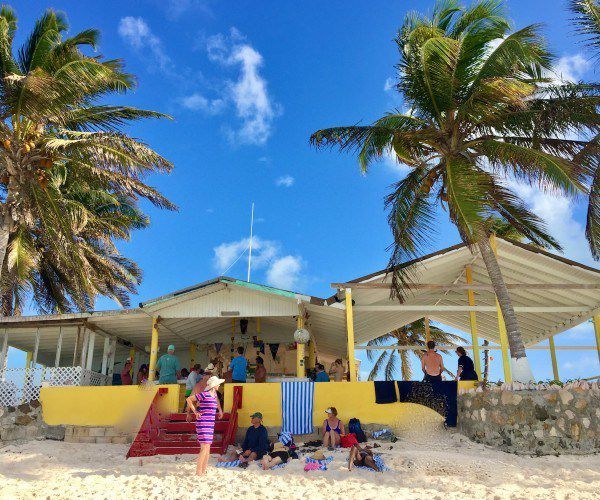
Why did Catherine’s Café make the list? Barefoot-casual Catherine’s feels like the French Riviera. Naked toddlers running amok, with their half-naked mums running after them. It boasts a French-inspired menu, and a well thought-out wine list. Our effervescent bartender, Damien, kept us in good spirits, recommending personal faves from Catherine’s extensive G+T menu. Enshrouded by neem trees, and with an intimate beachfront location, Catherine’s Café practically begged us to spend an afternoon there—so we did.
USP: It’s not often that a place can perfect both the beach bar, and the beach restaurant experience, simultaneously. Neither is sacrificed at Catherine’s Café.
3. Anegada, Cow Wreck Beach Bar
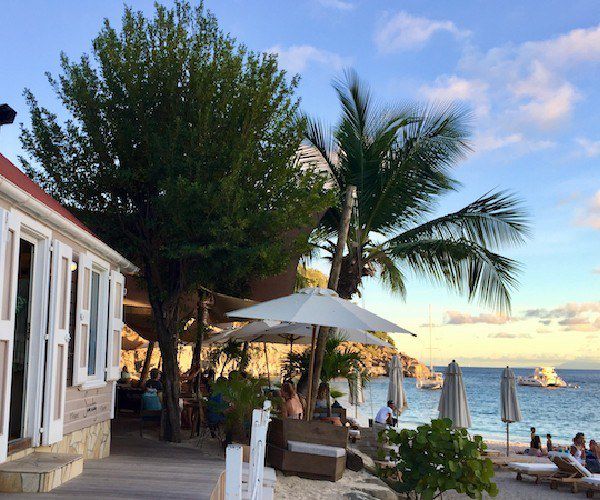
Island vibe: Utterly remote
Seventeen nautical miles from Virgin Gorda, a floating speck on the edge of the British Virgin Islands, is where we found Anegada. A literal pancake of an island, 28 feet tall at its highest elevation, the name Anegada, means ‘drowned island’. That Anegada feels so incredibly far flung from civilization is exactly what makes it so enchanting.
Cow Wreck Beach, on the northwestern coast of Anegada, is a pretty unusual name. I decided to do some Google digging. In 1929, a 380 foot-long steel freighter called The Rocus was en route to Baltimore from Trinidad. The Rocus’s cargo was filled with cow bones that would later be ground into fertilizer. The freighter made an unexpected, and devastating, final stop when she collided with Anegada’s treacherous Horseshoe Reef. Since then, the ocean floor has remained eerily scattered with cow bones. As for the freighter, it’s still lodged on its starboard side, just beneath the water’s surface, and has barely budged since 1929. So the legend claims.
Why did Cow Wreck Beach Bar make the list? Cow Wreck has few true walls. Concrete, colorful peeling paint, plastic chairs, a pitched aluminum roof, and a no frills decor, is what defines this dive-y, yellow bundle of fun, on the edge of the island. The food was somewhat forgettable, but no one seemed to mind, as an escape from reality (along with the stiff drinks) more then made up for it. Sea urchin shells, thousands, in every size, and in all the varying degrees of white that the sun can bleach, line the pristine beach. The color of the sea is one I thought could only be achieved by an Instagram filter. Layers upon layers of foamy turquoise surf rolled up against the wide, white sandy shore.
USP: As I often like to say, some of the most interesting places in the world are the hardest to find. Cow Wreck Beach—thank you for proving my point.
2. Shellona Beach Club, St Barths
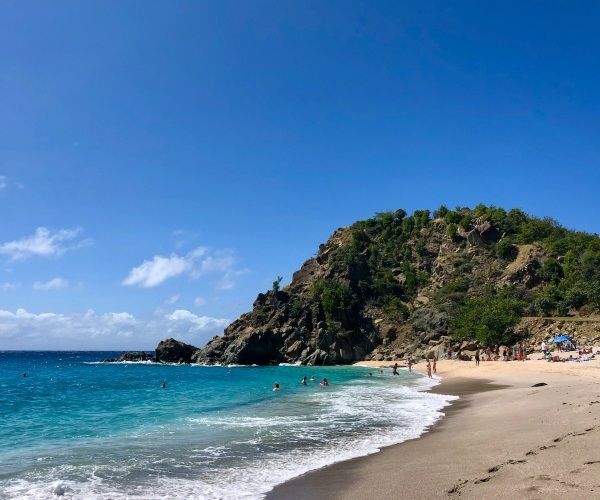
Island vibe: Over-the-top glam
I don’t know who in our group spotted that last empty table, wooden legs nestled unevenly into the sand, flattened beach pillows, and low stools surrounding it. Regardless, we grabbed that table, and stayed put, for hours. Our time spent at Shellona ‘shell on a’ Beach, on glitzy St Barths, was mood-lifting and laughter-filled. One could while away more than one late, sunsetting afternoon at this Greek-inspired restaurant/bar. The scene often includes caftan-clad models weaving leisurely around the tables—a St Barths catwalk of glamorous women donning the latest island-glam clothing, or lack thereof, from the neighboring boutique.
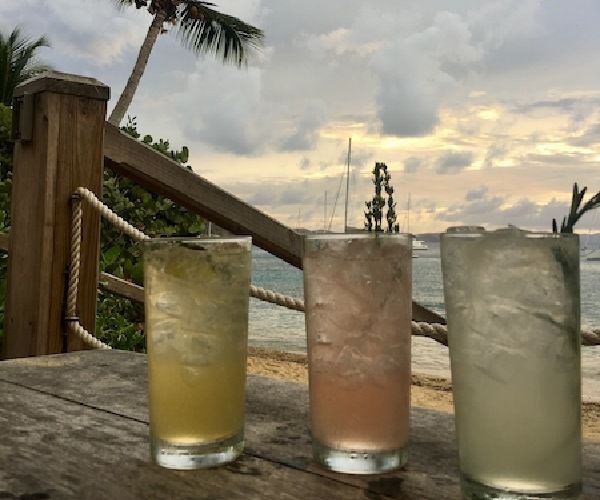
Why did Shellona make the list? I was hard pressed to tell where the beach bar ended, and where the beach began, as they blur into one on this cozy bay, just a few minutes walk from the shops of Gustavia. What was possibly once a well-kept secret, is a secret no more. And, while Shellona is likely the least hidden of my top five faves, and is soaking up its off-the-charts popularity, it nonetheless keeps me wanting to come back for more.
USP: Glam, glam, and more glam. Part beach club, part beach bar, all-around killer views.
1. The Rum Bar, Cooper Island
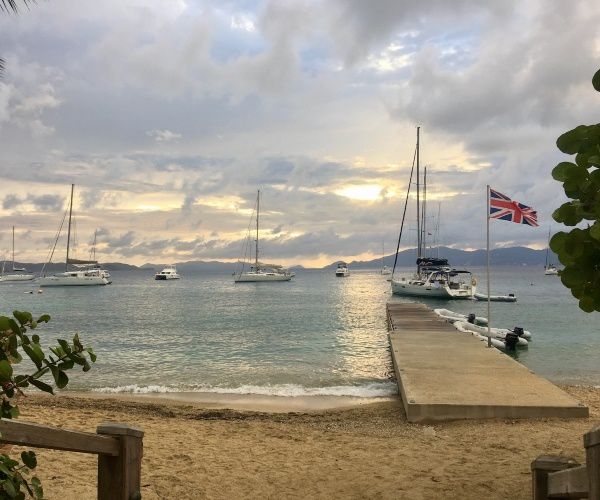
Island vibe: Barefoot beach shack
When our sailboat grabbed one of the last available moorings in Manchioneel Bay, off the shores of Cooper Island, I felt like a survivor about to crawl onto a deserted beach. The people who were lazing upon the wooden decks of the Rum Bar were scrappy and barefooted, semi-drunk, and happily marooned. It was as if we had found a hidden outpost, a tiny island jewel box, where a lucky few were escaping the outside world. Idyllic.

Why The Rum Bar made the list? There is an authenticity to Cooper Island that is somewhat unique to the British Virgin Islands, which are often heavy with tourists, and can sometimes feel manufactured. A clear sign that the Rum Bar, part of the modest Cooper Island Beach Club, is all it’s cracked up to be, was that we noticed yacht crews hanging at the tiny bar—the real-life version of ‘Below Deck’. If the Rum Bar was where they were choosing to spend their limited free time, we knew we were on to something good.
Although a shoe box in size, the bar’s atmosphere feels so enveloping, that it is just as tempting to sit inside, as out. Rows of rum stand at attention, waiting to be poured, along the wall behind the bartender. I couldn’t help but feel a pang of envy for his seemingly fly-by-the-seat-of-his-pants Caribbean existence. The weathered, and layered, wooden decks, and shabby thatched umbrellas are perched to take advantage of the sailboat views in the bay. The boats who had been fortunate enough to grab an elusive mooring earlier that day. We felt like we were a part of a finite, exclusive club for a fleeting moment in time.
USP: The remote and rickety shack-chic setting that, true to its name, houses 280 different rums.
By Jamie Edwards
Villas in South Africa to quarantine in

As exclusive-use properties become even more sought after in a post-pandemic landscape, these are my top six villas in South Africa for a luxurious and scenic breakaway.
Kubili House
The Kruger National Park remains South Africa’s Mecca for wildlife visitors, and in a quiet corner of the reserve is one of its best-kept secrets. Kubili House is an exclusive-use home and African safari experience par excellence. Sleeping ten in five bedrooms, Kubili spreads out over an impressive 26900 square feet. Four swimming pools, a spa, and a steam room help guests settle into a slower pace of life. Since you’re situated on a large dam you don’t even have to leave the comfort of the deck to spot wildlife. When you are ready, your personal field guide and tracker are available for safari – including three fully-equipped camping vehicles for those wanting an equally luxurious experience under the African sky.

Synergy Treehouse
In the quiet seaside village of Scarborough, one hour from Cape Town, the majestic Synergy Treehouse is hidden in an indigenous hillside forest. This über luxury home is completely glass-encased, blurring the boundaries between the stylish interior and lush exterior. Synergy follows the steep property with three distinct levels. On the ground level, there’s a pool deck and the master bedroom. A glass spiral staircase connects them to the lounge, kitchen, and main deck. Lastly, the second bedroom is suspended high above the trees, with its bathroom built into the adjacent rocks. Countless space for relaxing, all seamlessly flowing into each other.

Villa The Cherry
De Kelders is a sleepy coastal town, a little over two hour’s drive from Cape Town. Villa The Cherry sits proudly on one of the town’s prime clifftop-locations, with sweeping views out over Walker Bay below. ‘The Cherry’ has three ensuite bedrooms, a courtyard with a pool and then an open-plan lounge, dining room, and kitchen – all with unsurpassed views. With automated blinds and sliding doors, at the touch of a button, you’re directly connected to the gorgeous surroundings.

Bordeaux on Brittania
The West Coast has long been a sought-after place of retreat, two-hours North of Cape Town. Britannia Bay is one of the small towns that skirt the coast and its various bays. A strip of luxury white-washed homes straddles the 3km beach with their front gardens literally on the beach. Bordeaux on Britannia is built to take full advantage of its oceanside position – particularly from the upstairs landing where we’d daily admire the sunsets from. The azure ocean is even visible from the central courtyard’s heated pool. Expect impeccable décor that feeds the spirit and sensitively echoes the relaxing ethos of West Coast simplicity.

Dolce Vita
If quaint country towns appeal to you, then the village of McGregor, a two-hours’ drive from Cape Town, should firmly be on your list. Known locally as the village on the road to nowhere – the road to the town really goes nowhere else. Cradled by gentle hills McGregor is a place of peace and perfect for an isolated getaway or working holiday. Dolce Vita is one of the grander of the local homes, with two distinct wings – suitable for two couples or larger families. Whether it’s relaxing at the pool, sitting around the outdoor fire, or glass-fronted lounge – the house is spacious and most importantly – all yours.

AtholPlace House & Villa
With the prestigious Relais & Chateaux stamp of approval, AtholPlace is situated in the heart of Johannesburg’s leafy and swanky Northern Suburbs. AtholPlace offers two stay options: the four-bedroom Villa with landscaped private garden, sparkling pool, and boma, and the nine-bedroom private with its own bar, library, fireplace, heated swimming pool, gym, and lush garden. They are two exclusive-use options, but as they’re on adjacent properties, they can also be used together to sleep up to 26 in total. A stone’s throw from the glitz and glam in Sandton and a 25-minutes’ drive from O R Tambo International airport.

Doringbos Farm
To truly escape it all, in the glorious remoteness of the Cederberg Mountains, 3 hours from Cape town, hides a truly remarkable stay. Doringbos Farm enjoys a hilltop position, staring down at the perennial Doring River below. Up to 20 people can be accommodated in the various luxury chalets where no expense has been spared, for possibly the plushest mountain escape, you’ve ever experienced. Included in the stay is access to bicycles, quad bikes, fishing equipment, horse riding, kayaks, and much more. There’s even a hide on the dam to enjoy sundowners and watch local wildlife come for a drink.

by Jared Ruttenberg
Best kept secrets in Florence

Nestled in the Tuscan countryside’s gently rolling hills, Florence exudes a unique elegance and offers endless possibilities for those who love art, history, wine, food, and artisan traditions. In essence, Florence has it all!
Considered the Renaissance’s birthplace, Florence has an artistic heritage that is difficult to beat, bursting with artworks created by some of the most famous and influential artists in history, from Michelangelo’s masterpiece, David, to breathtaking paintings by Botticelli, Leonardo, and Raphael. The patronage of the wealthy and powerful Medici family, who controlled Florence throughout much of the Renaissance period, paved the way for the city’s cultural geniuses to create such masterpieces and, in turn, give birth to the Renaissance movement.
Amid such a rich cultural and historical landscape, it’s easy to feel overwhelmed. Having consulted our local experts, we are ready to share Florence’s best-kept secrets, so you can go beyond the famous sights and museums and delve into a full and authentic experience of this magical city.
Artistic hidden gems
As the Renaissance’s birthplace, Florence is adorned with masterpieces from some of history’s greatest creators. The Uffizi Gallery and the Accademia Gallery are the most renowned art galleries in Florence, housing some of the world’s masterpieces, from works such as Botticelli’s Birth of Venus. Fabriano’s Adoration of the Magi, and Michelangelo’s original statue of ‘David.’

Florence has many more magnificent galleries and museums filled with equally exquisite pieces and hidden gems for those who want to venture off the beaten path and dig a little deeper. While many travelers climb up to Brunelleschi’s red-tiled Duomo, few visit the Museo dell Opera del Duomo, nestled just behind the cathedral.
The National Museum of Bargello is set in one of the oldest buildings in Florence, a former city jail. Touring this quiet and crowd-free gallery with a local curator allows you to admire the exhibits at your own pace, away from the haste of the city’s more famous museums. Here you can discover an impressive assortment of Donatello and Michelangelo classics. For Renaissance enthusiasts, the Bargello is to sculpture what the Uffizi is to painting.
Gardens and parks: where nature meets history
Despite being a compact city of architectural beauty, Florence has numerous public and private gardens that offer refuge from the fast-paced Centro Storico or historical center.

Walk along the tranquil River Arno to Palazzo Poggi and then continue up to reach Piazzale Michelangelo to witness the beauty of Florence in all its splendor. A recent addition to the list of monuments in Florence, this piazza was created in 1869 by architect Giuseppe Poggi as part of a significant restructuring of the city walls. I admired the bronze replica of David’s statue (placed in honor of Michelangelo) before taking a seat on the steps of the square and admiring stunning panoramic views of the entire city. Watch the sunset over the terracotta rooftops and surrounding countryside dotted with villas, vineyards, and orchards as Florence’s cathedral, the Duomo, dominates the landscape with its architectural uniqueness. From these heights, you can get an almost birds-eye view of the city’s impressive monuments, churches, and varying neighborhoods.
If you are traveling to Florence in May or June, visit the immaculate Rose Garden to witness its beauty in full bloom. Found just below Piazzale Michelangelo, this beautiful garden is home to over 350 different rose species varieties, alongside numerous other plants, such as lemon trees and irises. Lose yourself in the sweet aromas of this botanical haven and admire the twelve bronze statues of the famous Belgian artist Jean-Michel Folon.
Lying just south of the Arno River, the majestic Pitti Palace is Florence’s largest architectural monument. Designed by Filippo Brunelleschi, it belonged to the Pitti family and was later sold to the Medicis to become the grand ducal family’s primary residence. From Costume to Silver, the Pitti Palace has seven fascinating historical and cultural museums ready to be explored with your expert local guide. However, the rolling hills behind the tower, the Boboli Gardens, are truly breathtaking. The vast green expanse is a beautiful example of ‘green architecture’ within the city center, filled with ancient and Renaissance statues and adorned with grottos and large fountains. After losing yourself in history, spend the rest of the afternoon away from the hustle and bustle of the city center, strolling through these picturesque gardens.
Flavors of Florence
Italy is famous for many things, but in particular, for its cuisine, and in Florence, restaurants abound at every level. Beyond the beautiful carb-fueled creations of pizza and pasta, Florence is heaven for meat lovers. The signature bistecca alla Fiorentina is a large T-bone steak seasoned with olive oil and sea salt and is often enjoyed with Tuscan red wine. This popular dish was invented during the Medici family’s reign when cuts of meat were grilled on bonfires during large celebrations across the city. Today, Florence is filled with both traditional and artisanal steak restaurants, alongside many new and more modern takes on this Florentine specialty.

While in Florence, be sure to experience Aperitivo, a unique Italian ritual of enjoying a pre-dinner bite and aperitif cocktail. This vibrant custom has become very popular in Florence, with many new, trendy bars opening up to offer a more contemporary style, steering away from typical Italian cold cuts and moving towards vegetarian and vegan options.
After a Uffizi Gallery tour or a stroll around the nearby Piazza Della Signoria, visit All’antico Vinaio. Once a single shop, the family-run business has opened three more shops on the same street and is now world-famous for its traditional and delicious paninis.
Florence’s bustling central market, the Mercato Centrale, is both a cultural adventure and food heaven. Wander through the colorful stalls selling fresh fruits and vegetables and the typical vendors selling fish, meats, and cheeses alongside specialty shops boasting local delicacies. Immerse yourself in local life as you watch the pasta machines at work and witness the playful interaction between buyers and vendors in the many little ‘botteghe.’ The upstairs level has been revitalized as an ‘indoor piazza’ lined with food stalls that call upon old Italian cultural traditions. Tour the market and discover the secrets behind the culinary traditions of Italy.
Artisans in Florence
Florence has always been a hub for creation, innovation, and brilliant minds. And though the city’s crafts have transformed since its glory days, many of these age-old techniques are still alive today. Artisanal trades such as leather, gold, bookbinding, and marbled paper all date back through the centuries, and the excellence of the work is there to appreciate.

Take a tour with a local guide and wander through Florence’s narrow streets, from the Oltrarno neighborhood to the main cathedral, and discover a blend of traditional artisans and innovators reinventing old crafts with a modern twist. While witnessing these gifted craftsmen at work is mesmerizing in itself, learning about the artisanal history with a guide allows you to discover the city’s real character through its expert craftsmen, who have been passing on their knowledge down through the generations.
While Milan might be one of the world’s four fashion capitals, Florence is a fashion center. The city is the birthplace of Guccio Gucci, who founded the world-famous fashion house in 1921. The high-quality leather goods crafted by skilled craftsmen quickly took over the world and built a reputation that remains synonymous with a luxury 100 years later. For fashion lovers, Florence offers shopping options ranging from high-end, along with the city’s most fashionable via Tornabuoni, to funky and unique in the side streets and artisan workshops.
by Anna Mascaro
The best aprés ski in Zermatt

Despite everything, there will be a smattering of bookings over the coming season in most resorts. Some folks will find the wherewithal to travel and enjoy a week or two in the snow. It’s been very tough for the travel industry so I guess we have to be very grateful for small mercies. All that aside here’s where it gets good. And something I’m very much looking forward too. A spot of apres-ski! After a beautiful day on the mountain, many, me included, feel the need to celebrate our efforts by letting our hair down usually aided by a cheeky beer or three. A beer or three? Ha, who am I kidding , it’s usually much more than that. And anyway, it would be rude not to. Hence the popularity of apres-ski. Zermatt has many lively apres-ski bars. Here are 4 of the best, Bring it on!, I’ve missed it.
Henna Stall
While skiing down the lower section of the Furi-Zermatt slope you’ll probably hear the pumping house beats or the Hennu Stall house band giving it some. Like wasps round a jam jar, you’ll next see the happy throng bobbing up and down on the terrace. This is party central and one of Zermatt’s liveliest and some would say craziest apres-ski bars. Dancing on the tables is par for the course and many a ski suit has been cast skyward as some over enthusiastic crazy has decided to strip down to his Calvin Kleins and beyond. Fancy dress is often seen here, with anything from Captain Chaos to Buzz Lightyear throwing shapes on the dance floor. You don’t have to join in, of course, you can just watch from a distance and enjoy the shenanigans, albeit wearing a face splitting grin. The fun is infectious, aided of course by the consumption of a beer, gluwein or a cheeky Jägermeister.
A novelty here is an old ski made into a drinks tray, usually lined up with Jägermeister shots. Jägermeister’s ingredients include 56 herbs, fruits, roots, and spices, including citrus peel, licorice, anise, poppy seeds, saffron, ginger, juniper berries and ginseng. These ingredients are ground, then steeped in water and alcohol for 2–3 days. Afterwards, this mixture is filtered and stored in oak barrels for about a year. When a year has passed, the liqueur is filtered again, then mixed with sugar, caramel, alcohol and water. It is filtered one last time and then bottled. Contrary to an urban legend, Jägermeister doesn’t contain deer or elk blood but it is bottled rocket fuel and at 35% proof you’ll soon be flying after you’ve necked a couple of these bad boys.
Hennu Stall can be reached easily on foot from Zermatt in 30 minutes, or you can take the Klein bubble up to Furi and then ski or walk down. It is virtually impossible to spend a skiing holiday in Zermatt without getting to know about Hennu Stall and it’s legendary status.
Paperla Pub
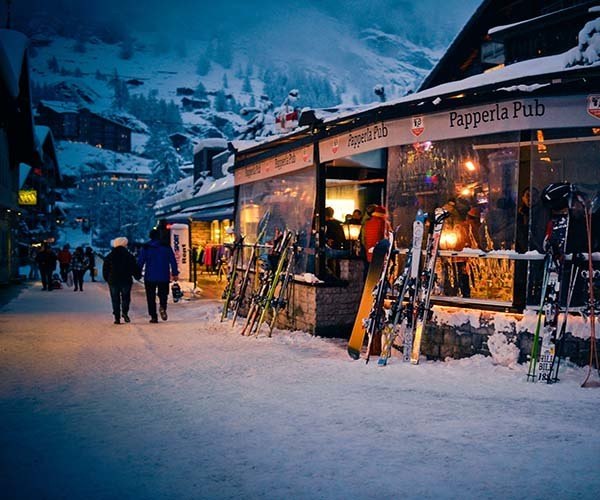
If you’ve not had enough and you want to carry on the party in town your next stop should be the Paperla Pub. Open 365 days a year, you know the place is popular by the amount of ski’s propped up outside the bar.
Live music, DJs, a cosmopolitan crowd and a crew that encourages a great atmosphere and a spontaneous party mood are all the ingredients you want for an apres-ski party. In winter, après-ski starts daily around 4 pm. Those who like hot drinks can celebrate with Jägertee and mulled wine on the terrace. Or settle into the warm interior of the Irish pub style bar and catch the vibe. Stu and Ronnie are the bars resident fire starters. They never seem to get tired of whipping the crowd into a frenzy with jolly japes and drinking games. They can often be seen cavorting atop the bar egging each other on to even more outrageous dares. It’s a lot of fun and as cabaret goes, it’s certainly original. Stu and Ronnie have become good friends of mine and they never stop with the fun, even on their rare nights off they are party starters. They are a couple of naturals and the Paperla Pub owes it’s legendary status to their never ending good humour.
Cervo

The Cervo is a hotel first and foremost which boasts a large outside terrace for a spot of apres-ski. The Cervo is situated in a delightful spot, on the side of the piste and après-ski is part of the Cervo lifestyle and concept which they boast is the most sophisticated in the Alps. With different bands and DJ’s the entertainment is varied and lively and the setting couldn’t be better. If you want a more refined apres-ski experience the Cervo, with it’s cigar room and selection of local beers is the place for you. Less raucous than the Henna Stall or the Paperla Pub, the Cervo offers a more dignified experience. Being a hotel, the apres-ski winds up early but you can summon an electric taxi or ask for the code to the private lift that will deposit you in town so you can party on.
Snowboat

And you’ll want to continue the party in the Snowboat, which is actually in town. This enchanting and unique boat-shaped building by the river is home to the Snowboat Bar and Yacht Club Restaurant. The venue was designed by local legend, Heinz Julen. His projects are talked about in reverential tones and attract a lot of interest worldwide.
The Snowboat is a lively venue serving après-ski drinks and wholesome à la carte as well as exquisite cocktails made with premium spirits, fresh ingredients and lots of love. The Snowboat is legendary in Zermatt and a favourite haunt of the locals, who obviously have insider knowledge and know all the best places. The Snowboat is a more sophisticated apres-ski venue, a virtue it shares with the Cervo. Getting up the next morning to catch the early lifts might be tricky but you’re guaranteed a great vibe and a hospitality that makes the Snowboat packed most nights.
By Dan Frith
Great ski tours in Europe
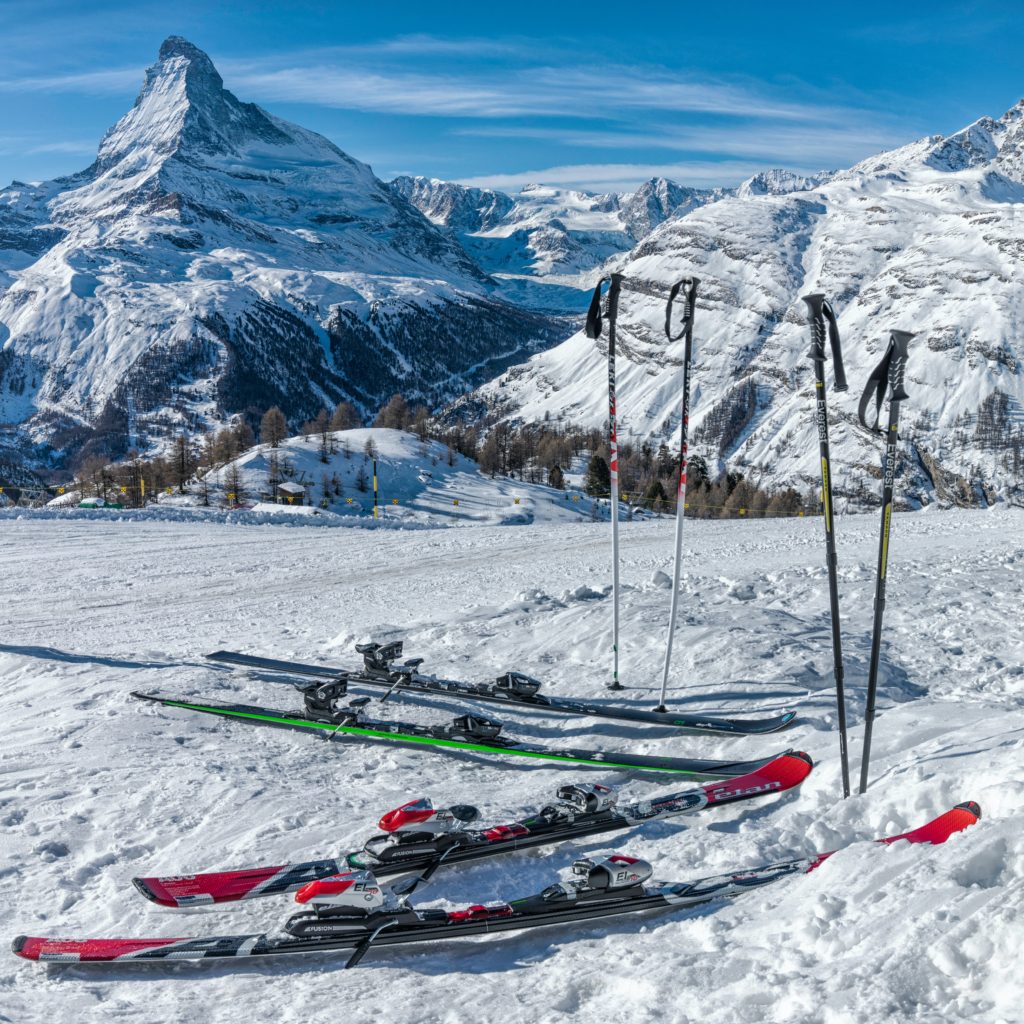
There’s time for things to change for the better, of course, but by now, most people would have already booked this winter’s ski trip and would be counting down the days. Despite the best guarantees that deposits will be refunded, people are understandably very nervous about committing to a vacation. I thought I’d share with you my experience of my last day of skiing, back in March, the day they pulled the plug. It happened to be Friday the 13th, a bad day, as it turned out. The last day on the mountain made me think of other great ski tours. Here are my picks.

The Schwarztor ski tour
I was up bright and early that day, and we were heading to Klein Matterhorn at 3883M, the highest lift in Europe. We were about to embark on The Schwarztor ski tour. The Schwarztor Tour is a short ski ascent and traverse followed by an enormous freeride descent over varied terrain. The trek passes through heavily crevassed glaciers that can be avalanche prone. While not a challenging tour, the risks must be taken seriously.
Things weren’t looking too good when we had to hold out at Trocknersteg due to the Klein lift being temporarily closed due to the weather conditions. However, our Mountain guide saved the day as he organized a ski lift up to Klein. A welcome solution and thrilling ride that only added to our little adventure.
Our goal was the Schwarztor itself, a narrow pass at 3700 meters that’s nestled on the Swiss Italian border and your entry to the Schwärzegletscher. A gentle traverse, followed by a short climb, leads from the Kleine Matterhorn station to the pass itself. Once you’ve reached the Schwarztor, it’s time to pull on your skins.
The glacier descent demands careful navigation among crevasses and seracs for hundreds of meters. While skiing is never steep, it is critical to find the right line to get through the glacier safely. Once you are off the glacier, you’ll enjoy more normal ski terrain before entering the narrow Gorner Gorge for an exciting re-entry into Zermatt. The Gorge is a classic Alpine exit with a fast track down technical terrain. In total, the descent is about 2 kilometers, and thanks to the differing terrain, it serves as a great intro to Alpine skiing.
That morning our mountain guide had pre-warned us that this weekend the resort would likely lockdown. We should enjoy our day and make the most of tomorrow, the last ski day of Season 2019/20. As it turned out, we returned to town that afternoon to rumors that the resort was about to close a day early. No sooner had I returned my skis to the ski room and started to frantically call friends to arrange one last ski day on that Saturday, it was already over. The lifts would be closing that afternoon, and that would be that for 2019/20
An unfortunate day and a lot of uncertainty about what we were about to experience.

The Haute Route Chamonix-Zermatt ski tour
The ‘Haute route’ or high-level route is a six-day traverse across the mountains and glaciers between Chamonix and Zermatt. This spectacular journey traverses glaciers and high passes through the alps’ very heart, taking in such peaks as the Rosa Blanche and Pigne d’Arolla. There are constantly changing views of Mont Blanc, Matterhorn, Grand Combin, and Monte Rosa.
This alp trek is ski touring at its best, high in the mountains, from hut to hut, with long climbs and stunning descents, only once dropping to valley level.
Starting in the heart of the Mont Blanc massif and ending up in the shadow of one of the most famous mountains in the Alps, the Matterhorn, it is a journey that every ski tourer should undertake at least once in their lives.
The Haute Route was first crossed on foot by an English party, at the end of the nineteenth century, before being gradually linked together on skis in the first quarter of the twentieth century. Zermatt is about 70 km from Chamonix, as the crow flies, but the actual route traveled is much further than this.

The Bernese Oberland ski tour
The Bernese Oberland is particularly famous for its substantial remote glaciers and accessible high peaks, so it’s understandably one of the best-loved routes. These Alps are the tallest mountain range, but all made easily accessible by the historic railway that runs through the Eiger’s North face.
In this 6-day itinerary, you visit the most impressive parts of the range. The starting point is Interlaken, the capital of the Jungfrau region. As you traverse across the Alps, your itinerary takes you on a magnificent route over high passes and sharp summits and gives some of the region’s best descents. At the end of the week, you tackle the famous 2000m descent down the Lotschental valley to the range’s westernmost extent.
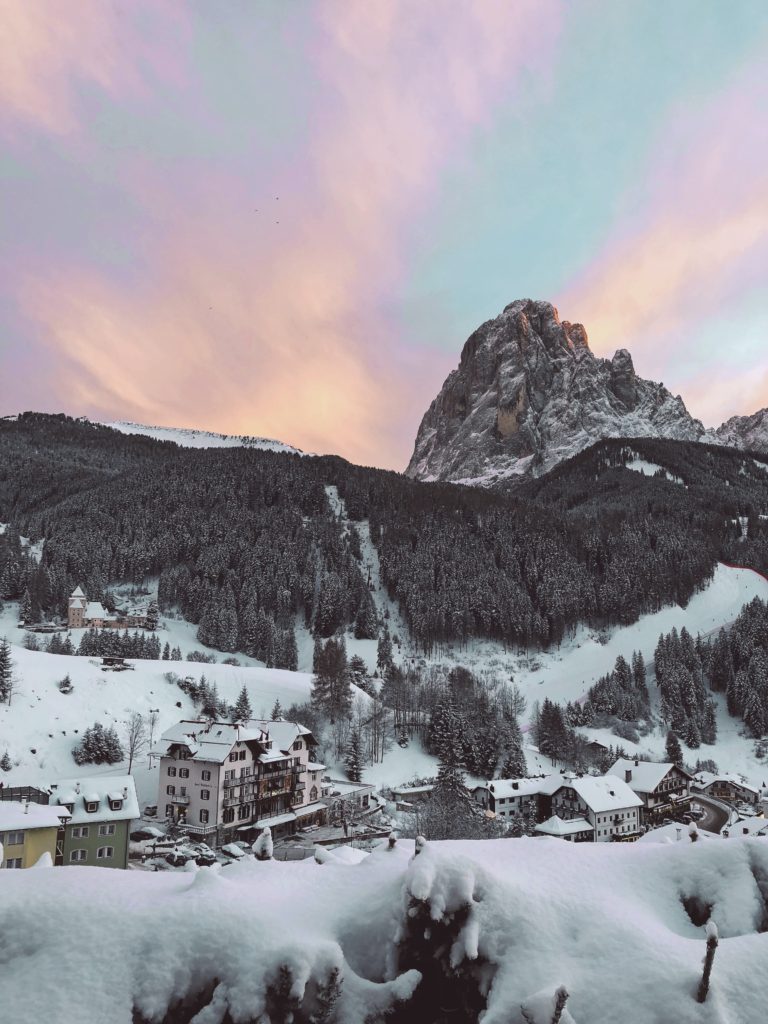
The Gran Paradiso ski tour
This five-day tour is a traverse of the Gran Paradiso National Park, finishing with an ascent of the Gran Paradiso, the only 4000-meter peak in Italy, not bordering another country. An excellent ski touring peak, this tour offers steep, wild, and tricky mountain terrain accessed from a series of relatively comfortable huts.
The Gran Paradiso national park, created from the private game reserve of Victor Emmanuel II and donated by his grandson, Victor Emmanuel III, in 1920, is Italy’s oldest national park. There is a multitude of wildlife, including large herds of ibex and chamois.
The skiing and mountaineering are excellent, with many options and itineraries to suit experienced ski alpinists. Previous ski touring experience and reliable technique, both ascending and descending, are prerequisites. Good physical fitness and familiarity touring also add to the margin for enjoyment.
Silvretta ski tour
The Silvretta mountain range is a ski touring paradise that runs along most of Austria and Switzerland. The Silvretta has a lot going for it. Lifts out of the Austrian village of Ischgl bring you quickly to the edge of the backcountry. Straightforward travel with light packs takes you up and across passes and to the tops of relatively easy ski mountaineering summits over 3,000 m.
The Silvretta Range has something to offer every skier. The slopes are perfect for a group of intermediate-level skiers, while those on their first hut-to-hut ski traverse are sure to have a great time.
There’s also a much more exacting traverse. This traverse is for very fit and experienced backcountry skiers. The traverse is longer, covers a greater distance, and includes three more huts and several more peaks.
by Dan Frith
Discover Basel, a city of museums

There is no other more cultivated city in Switzerland than Basel in the north of the country. This city has always been the center of art and culture. Starting from the 1500s, Basel was home to many well-known artists like Hans Holbein and Albrecht Dürer, as well as public figures like Nietzsche and Erasmus, to name a few. They were driven to move to Basel where they lived, worked and imprinted their irresistible legacy. Art collecting has a long history in Basel since, in 1661, it was the first European city that welcomed art collections. Here, even non-artistic souls become one!
Despite the city’s small size, Basel continues to celebrate art throughout the year. Many events are socially recognized and even renowned internationally. It is hard to believe that for 37 square kilometers, there are almost 40 museums in Basel, each worth visiting. Here we look at some of the most exquisite museums to explore on your next visit to Basel.
The Foundation Beyeler

This art museum is home to modern and contemporary art and was founded by the couple Ernst and Hildy Beyeler. Originally, on the current museum site, there was an antiquarian bookshop owned by the Beyelers. In 1952 they renamed their business to “Galerie Beyeler”, which was the basis of their new endeavour, but it was not until 1997 that the actual museum was founded. Foundation Beyeler is the most visited art museum in Switzerland and hosts prestigious exhibitions with worldwide notoriety. One of them was dedicated to Picasso’s works from the beginning of his career – the Blue and Rose periods. Another recent one was Edward Hopper’s works, which was successful despite the situation in 2020. If you are not sure what to do in Basel one day, we would highly recommend visiting The Foundation Beyeler for anyone who values art and is eager to learn about it.
Kunstmuseum

The Kunstmuseum (Art Museum) is a true symbol of Basel’s commitment to art. The museum keepscollections from Old Masters to masterpieces by modern and contemporary artists, and has been recognized as the fifthbest museum in the world. Pablo Picasso was involved in the museum’s life and two of his paintings – Les Deux Frères and Arlequin Assis – were on permanent loan to the Kunstmuseum Basel and due to be sold on the international market in 1967.However, most of Basel’s population decided to keep these paintings permanently. A referendum resulted in six million Swiss francs from tax money, whilst the remaining two million Swiss francs were donated by Baslers and art lovers. Deeply touched by such a decision and recognition, Picasso gifted three more paintings and a large format compositional study for Les Demoiselles d’Avignon to the city of Basel.
Nowadays, the museum includes three different buildings. The Hauptbau (main building) was completed in 1936 and exhibits the museum’s collections, including art from Basel, medieval and Renaissance art, works from the 17th, 18th and 19th centuries, as well as the art of classic modernism and European post-war modernism. The Neubau (new building) was constructed in April 2016 and has direct access to the main building by an underground passage. While walking through the underground passage, you will be impressed by the exceptional contemporary art. The Neubau is home to special exhibitions held in the skylighted galleries and presentations of art from the collections. The Gegenwart is the third building, better known as Kunstmuseum Basel Gegenwart. It was one of the first museums devoted to contemporary art in the world. Pictured are works ofontemporary art from the Kunstmuseum collections. The museum also hosts lectures and discussions on selected works or about contemporary art in general.

Basler Papiermühle (Paper Museum)

Basel was a center of paper production in the 1600s and was seen as a humanist city. Many public figures and scientists valued this as a place to print and publish their work. The museum is located inside medieval paper mill walls, giving it an exciting and unique atmosphere. Here you will learn the whole process of creating handmade paper from scratch, to the finished result – a book. The fascinating part of this museum is the personalized touch provided to clients today. You can order your special paper to print business cards, certificates, diplomas and even marriage or birth announcements. You can be the creator of your own particular paper made in the oldest paper mill in town. You can also purchase wax stamps and send them out on a letter with your signature.
Tinguely Museum


Jean Tinguely was an innovative Swiss artist who created kinetic art. In most of his works, you will see motion since Tinguely was always interested in machines – how they move, the noises they made and their shapes. You can see one of his works in the city center next to Barfüsserplatz – Carnival Fountain (Tinguely Fountain). The museum holds 142 exclusive sculptures as well as his drawings and sketches that allow you to learn about this talented artist.
Naturhistorisches Museum Basel (Museum of Natural History)


In the heart of the artistic city on the Münsterhügel near Basel’s cathedral stands the Naturhistorisches Museum. Visitors are usually welcomed by an amusing skeleton which dresses accordingly depending on the weather! The museum is fascinating for all people and ages. Its collections date back to the Middle Ages and cover our planet’s whole natural history, from anthropology and osteology to zoology and mineralogy. The valuable biological and geological collections have been looked after for over 300 years! Visit each showcase room and be surprised by the history and things you have never seen or heard of.
But let’s not forget other museums that also deserve everyone’s attention. For instance, the Museum of Pharmacy has the most extensive collection of pharmaceutical history. Or the Cartoon Museum which showcases satirical drawings and cartoons to the public. If you stay in the city center, it is impossible to miss the Toy Museum, since their vitrine is always fully decorated all year round; one reason to visit can is the biggest teddy bear collection in the world!
And now, after reading our unique museum guide, you are all set to go and explore them on your own or during a Basel walking tour! But keep in mind that most of the museums are closed on Mondays, which makes Basel a perfect spot to visit on the weekends or any other day of the week.
By Wanhua Qiao
The best way to spend a long weekend in Chicago
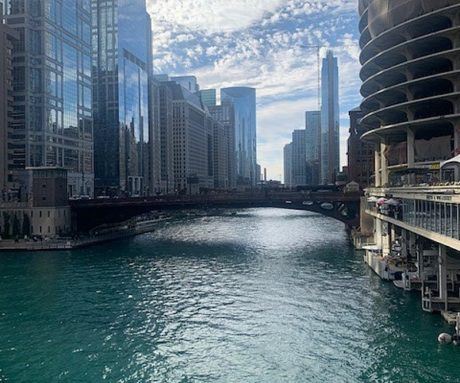
Short on time? That doesn’t mean you can’t make an escape to take a much-needed break from everyday life. In fact, you can pack plenty of luxury into a weekend if you plan accordingly. The trick is to spend as little time traveling and as much time enjoying yourself as possible, because when time is limited, every second counts.
One of my favorite spots for a getaway is Chicago. It feels close to home because it’s easily accessible through O’Hare International Airport from almost any point in the US. Stay in the city in an upscale hotel, and you’ll be in close proximity shops, excursions, and dining galore, plus the posh accommodations ensure you’ll be soaking up luxury through the entirety of your trip.
Another way to optimize your stay is to plan an agenda to check off the most important items on your must-see list. Not sure where to start? You’re in luck! Ahead is an itinerary which – in my opinion – offers a taste of the best things the city has to offer.
Author’s note: Before booking your trip, I highly recommend checking each location’s website to view up-to-date information regarding COVID-19 restrictions and protocols.
Your Chicago weekend itinerary:
Saturday
1:00 pm – Lunch at Manny’s Deli
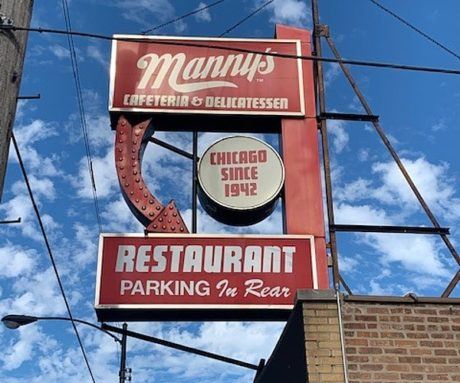
Have some time to spare before check-in? Grab a sandwich that’s stacked high from Manny’s Deli. A 15-minute drive from the hotel, this is the BEST Jewish deli that I’ve ever been to — and this is coming from a born and bred New Yorker! Try their Signature Reuben and matzo ball soup, you won’t regret it (they have a mouthwatering breakfast menu, too).
3:00 pm – Check-in at Thompson Chicago
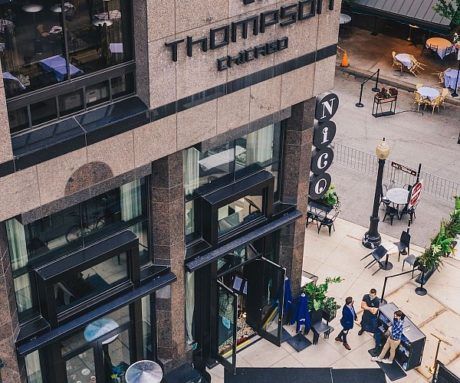
I love hotels and consider myself a bit of a hotel snob. Since I prioritize style and luxury, the Thompson Chicago is my first choice. With its exposed brick walls and plush velvet furniture, Thompson Chicago is both upscale and inviting. I booked the 19th-floor luxury junior suite, which boasted posh decor with an equally lavish view. From my window, I could gaze across tree-lined neighborhoods, the Great Lake waterscape, and of course, the city skyline.
4:00 pm – Shoreline Sightseeing Tour at Michigan Avenue
A short six-minute cab ride or 20-minute walk away, you’ll find Shoreline Sightseeing’s Michigan Avenue dock where boat tours depart almost once every hour. I climbed aboard for an hour-long Architecture Tour, which offers a unique view of Chicago’s most famous buildings.
5:30 pm – Cocktails at Salone Nico
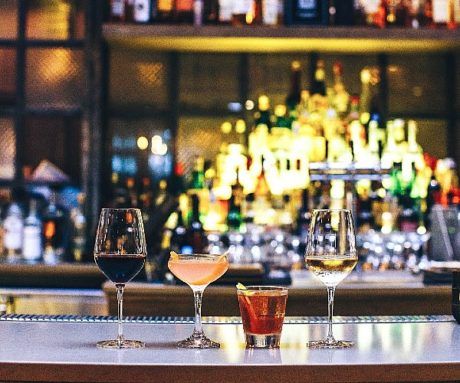
Lucky for you, some of the city’s best drinks can be found just a few floors down from your hotel room. Before dinner, grab a seat at sultry Salone Nico, the lounge within the Nico Osteria, which is inside Thompson Chicago. There, you’ll find light pre-dinner fare, an un-stuffy wine list featuring vintages from Italy and Greece, and classic cocktails (think: Palomas, Negronis, and Bee’s Knees) that are mixed up right.
7:00 pm – Dinner at Blue Door Kitchen & Garden
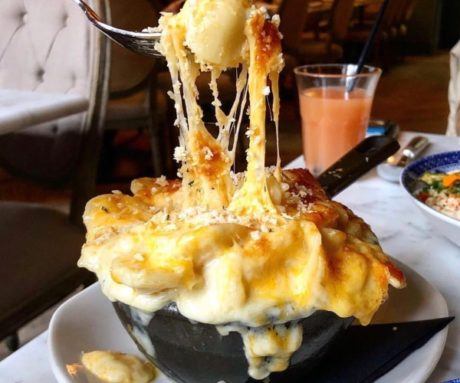
Once home to Chef Art Smith’s Table Fifty-Two, the acclaimed cuisinier (and former personal chef to Oprah Winfrey) re-opened the space as a farm-to-table restaurant that prioritizes seasonal ingredients and sustainability. With fresh foods sourced from Midwest farms — including the namesake Blue Door Farm, once Winfrey’s property — Chef Smith crafted a menu of comfort foods with his artistic twist.
Some offerings: cornbread served with peaches, whipped cream, and pecans; macaroni and cheese smothered in Mornay; buttermilk fried chicken with garlic mashed potatoes; shrimp and grits with andouille and tomato stew; and for dessert, hummingbird cake with pecans, coconut rumble, and coulis.
9:30 pm – Rooftop Nightcap at The J. Parker in Hotel Lincoln
If you love the view from your hotel room, you’ll be enchanted by an unobstructed look at Chicago through these panoramic windows. So, take a seat and savor the sights and a signature cocktail or two; unique concoctions like the Banana Matcha Gimlet and the Getty’s Herb with optional CBD bitters will intrigue your taste buds. Between the city lights and the complex flavors, you’ll want to sip slowly.

Sunday
10:00 am – Breakfast at Nico Osteria
Sleep in, then make your way downstairs to Thompson Chicago’s onsite Italian restaurant Nico Osteria for a decadent brunch dish to start your day. When I visited, I ordered the Dungeness Crab and poached eggs on focaccia, which I highly recommend if available. If not, they have plenty of other gourmet options like lemon ricotta pancakes with blueberry sauce and eggs Florentine on a rosemary biscuit with sautéed spinach.
11:00 am – Shopping at the Magnificent Mile
What luxurious weekend is complete without a splurge-worthy shopping spree? With the Magnificent Mile just a 10-minute walk away, spend a few hours browsing and buying top brands like Burberry, Tory Burch, Ugg, and so much more. The Mile is also home to malls of high-end retailers; check out the 900 North Michigan Shops, The Shops at North Bridge, and Water Tower Place.
1:30 pm – Lunch at Lou Malnati’s Pizzeria

On your way back to Thompson Chicago, stop at Lou Malnati’s 1120 North State Street location, which is practically next door to the hotel. There, you’ll sample legendary deep-dish Chicago-style pizza done right.
After a quick lunch, you can drop your bags and change for this afternoon’s kayaking excursion.
3:00 pm – Kayak Chicago Architectural Tour
Kayak Chicago’s home base is a mere 10-minute drive from the hotel, and you’ll head there for the late afternoon Architectural Tour. With all experience levels welcome, you’ll learn Kayaking 101 including safety procedures and paddle strokes before hitting the water. Once you’re a pro, you’ll get to cruise along the Gold Coast for a leisurely look at the city’s most important landmarks. The tour is three hours long from start to finish.
7:30 pm – Dinner at MAKO Chicago
MAKO is a must-stop for sushi lovers, especially after working up an appetite while paddling along Lake Michigan. Opened by renowned sushi chef B.K. Park, it features an omakase menu. This means the chef creates the courses day by day, offering a truly unique dining experience. Beverage pairing is also optional.
Because it’s omakase-style, you must make reservations, and currently, they’re serving at limited capacity. You can also get your meal to go and enjoy it in the comfort of your hotel room.
Monday
9:00 am – Breakfast at The Original Pancake House
Even though it’s check-out day, you can still enjoy a leisurely breakfast. Located directly across the street, The Original Pancake House is a neighborhood favorite and is open by 7:00 am if you happen to be an early riser.
The local chain serves up more than just pancakes; you’ll find fresh-squeezed juices, Belgian waffles, crepes, hash brown skillets, omelets, scrambles, and more.
12:00 pm – Check out from Thompson Chicago
All good things must come to an end, but after a weekend full of shopping, sightseeing, and eating, you’ll feel as refreshed as if you’d taken a much longer vacation.
You don’t have to vacation far or for long to reap the benefits of a change of scenery. Choose a centrally located hotel in a bustling hub and map out your agenda in advance. With a little planning, you can pack a lot of luxury in a short amount of time for a fun and fulfilling getaway.
Author’s note: Some stores, restaurants, and destinations highlighted in this article may have different hours and procedures due to COVID-19 or may be temporarily closed. Because of this, I highly suggest calling or checking the websites of individual locations before planning your trip.
By Eric Hrubant

